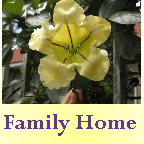

|
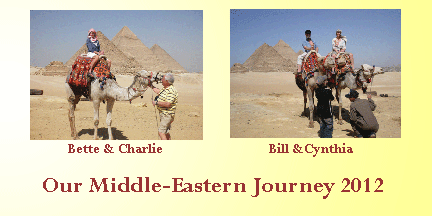 |
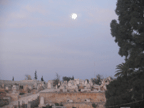
Jerusalem |
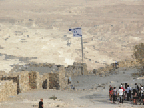
Masada |
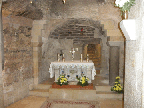
Nazareth |
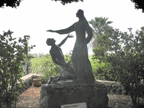
Tabgha |
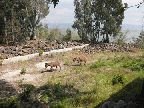
Capharnaum |
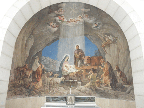
Bethlehem |
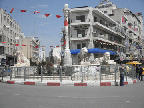
Ramallah |
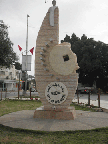
Jericho |
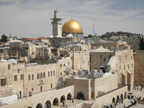
Back to Jerusalem |
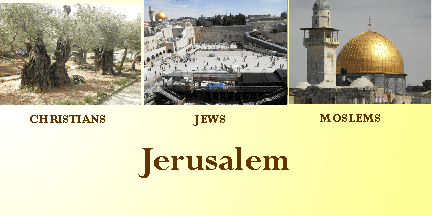
|
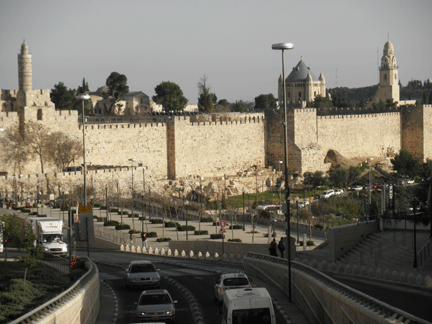
Old City View |
||
| Our El Al flight was uneventful, and we arrived in 70 degree weather at the beautiful Ben Gurion International Airport in Tel Aviv.
Along the left of the long hallway leading from the gate to the terminal is a glass wall, and outside a large garden with
the words "Welcome Home" in Hebrew, spelled out with plants and flowers.
Charlie and I had left from Orlando, Cynthia and Bill from Boston, but as we waited in the line to go through customs, we found each other, two lines apart. Excellent coordination! A good way to begin our adventure. The first thing we did in Jerusalem was walk to the Western Wall, where Jewish families gather at sundown to celebrate Shabbat, but because of a hotel mix-up, it was a while after sundown when we finally entered the Old City through Herod's Gate. Some of the revelry was still taking place in the plaza outside the Wall's sacred spaces. Lots of people were still milling about, and we came upon a group of young men line dancing. I walked into the women's side of the Wall where the mood was quiet, peaceful and reverent. A few women were reading at desks placed along both sides. (Stacks of books in Hebrew were on tables.) Small groups of women were sitting together in chairs close to the Wall. Several women were standing at the Wall, one touching it with her forehead, another with her lips, others praying by it. I walked up close, noticing the many notes tucked in its cracks. One had fallen on the ground, right at my feet. I thought about picking it up and sticking it back in the Wall, but I left it, feeling sorry for the person who'd put it there. I was in a holy place that was way beyond me. It was humbling. I put my hand on the Wall and prayed that all the people of Jerusalem would someday have the peacefulness of this place. When I saw the women facing the Wall as they exited, I did the same. The men's side, three times as large as the women's side, had a long table with papers and books on it in front of the Wall. Behind it stood a few Haredim (ultra-Orthodox Jews) facing the people. |
||
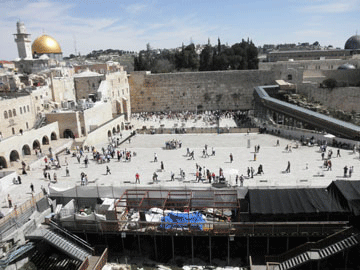
The plaza of the Western Wall |
||
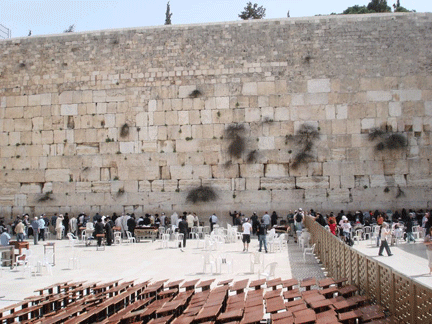
Men's side on the left, women's on the right. |
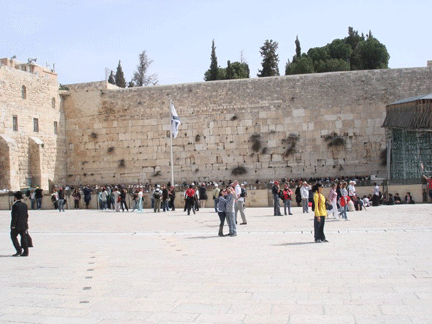
Plaza outside the wall. |
|
| By the time we left the Western Wall plaza, the shops in the Old City were closed and few people were around. It was eerie stepping on those ancient stones in the narrow walkways. | ||
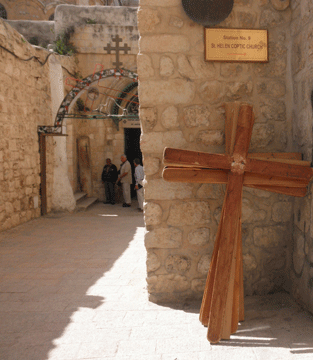 | ||
| An airport shuttle had dropped us at the end of a one-way street in Jerusalem because our hotel was on that street and the shuttle couldn't enter. The
sidewalks were lined with pulled-down, metal shutters and deserted. Our
hotel was in East Jerusalem, the Palestinian section, and we found out later
that all the shops were closed because Friday is the Moslem holy day. We
dragged our bags down the street to our hotel, the Capitol Hotel, up the
long flight of stairs, into the lobby to discover that the rooms we had
reserved were not available, and the language barrier made it impossible
to find out why. We had made our reservations well in advance, had paid
the $69 deposit, and I held the confirmation email in my hand. The desk
clerk, who was very apologetic, sent us down the street to another hotel,
which he said was comparable. It would be only for the first two nights,
he told us. We could have rooms at the Capitol on the third night. So, we dragged our bags farther down the street, into the tiny, dark, deserted lobby of The New People's Hotel. It was not comparable! A young boy appeared to help us with our luggage. Cynthia asked him his name and he smiled and said "Abraham." He was the only one we saw who seemed to work there. We dumped our stuff in the rooms and decided to ignore the negatives, like the Clapp's toilet seat not being attached to the toilet, and make the best of the situation because we were eager to get to the Western Wall at sundown on Shabbat. Early the next morning, Charlie stopped at the Capitol to express our dissatisfaction, and the manager told him we could have free breakfasts and dinners in their hotel while we stayed at the other one. After a few meals in the Capitol's dining room, we noticed that most of the people were Moslems and belonged to a group. I concluded that our reservations were likely changed to accommodate Palestinians, especially those in groups. And looking back now, that seems all right to me. | |
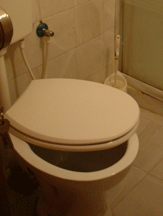
The hotel was shabby . . . |
|
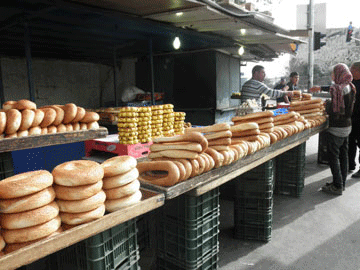
but the neighborhood was great! |
|
| In the morning, we went back to the Wall for a four-hour tour. Our guide, Isaac, whom we randomly chose among all the guides waiting
at the Jaffa Gate, was wonderful. He was knowledgeable, thorough in his explanations and very personable. We explored the Palestinian section,
the Jewish section, the Christian section, and the Armenian section.
The last part of his tour was The Way of the Cross on the Via Dolorosa: Jesus condemned to death, Jesus carries his cross, Jesus falls for the first time, Jesus meets his mother, Simon helps Jesus carry the cross, Veronica wipes the face of Jesus, Jesus falls a second time, Jesus meets the holy women of Jerusalem, Jesus falls the third time, Jesus is stripped of his garments, Jesus is nailed to the cross, Jesus dies on the cross, Jesus is taken down from the cross, Jesus is laid in the tomb. I couldn't tell if Isaac was Jewish, Palestinian or Christian, until after the tour. Exhausted mentally, emotionally, and physically from the intense four-hour experience in the Old City, we stopped with him at a juice bar for fresh pomegranate juice, and I asked him if he spoke Arabic so I could thank the juice bar man. He then gave me my first Arabic language lesson. He seemed very pleased to be my Arabic teacher. I wrote down words I would need for Jordan and Egypt, and we practiced saying them correctly. However, I found out later in Egypt that Jerusalem Arabic is different from Egyptian Arabic and had to find a second teacher. |
||
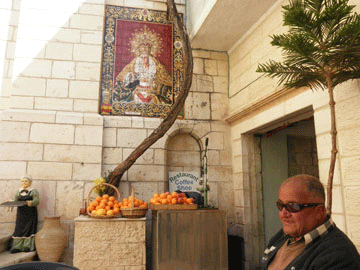
Isaac, our Guide |
||
| We said goodbye to Isaac and took a taxi to the King David Hotel. After our long day in the Old City, it was nice sitting in the
sun out on the patio, sipping cold drinks and nibbling on appetizers. Inside the King David, stretching from one end of the hotel to the other, is a
line of floor tiles signed by famous guests, including most of our recent presidents, entertainment icons, and dignitaries from around the world.
Photographing tiles of people we knew occupied Cynthia and me for quite awhile.
The weather was beautiful. We walked leisurely around the area, taking a few pictures, in no hurry to get back to The New People's Hotel. Our free dinner at the original hotel was excllent. |
||
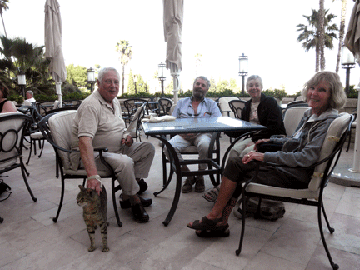 |
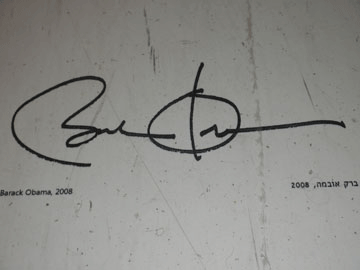 |
|
| Charlie and I each went to Mass, he to the Greek Orthodox
Church in the Church of the Holy Sepulcher in the Old City and I to the
Notre Dame Chapel in the Notre Dame of Jerusalem Center. I was sitting in
my seat before Mass and a woman tapped me on the shoulder and asked if I
would do the second reading. I was stunned and a little worried because
I didn't have my glasses with me, but I did it. The print was large and
I was familiar with the passage from St. Paul's Letter to the Corinthians.
The whole experience seemed amazing to me. I kept thinking, I'm in Jerusalem two days and I'm standing on the altar in this beautiful chapel reading this wonderful passage from St. Paul to a congregation of strangers from around the world. It was Corinthians 1: 22-25: "For Jews demand signs and Greeks seek wisdom, but we preach Christ crucified, a stumbling block to Jews and folly to Gentiles, but to those who are called, both Jews and Greeks, Christ has the power of God and the wisdom of God. For the foolishness of God is wiser than men, and the weakness of God is stronger than men." A nun from one of the African countries did the first reading, and a young man with a French accent did the third. The Notre Dame of Jerusalem Center is a guest house for religious and pilgrims that serves as an ecumenical and pastoral center for Jerusalem. It also has a professional promotion center for local Palestinian youth, and contains a permanent exhibition on the Shroud of Turin entitled "Who is the Man of the Shroud?" It is under the direction of the Legionaries of Christ and Father Juan Maria Solana is the pastor. After Mass I walked to the Wall to meet the others, and, still in a daze from my experience, I got lost in the Old City. When I finally made it to the Wall, I was excited to find Charlie and tell him about my experience, but he was too annoyed at me for being late to appreciate it. |
||
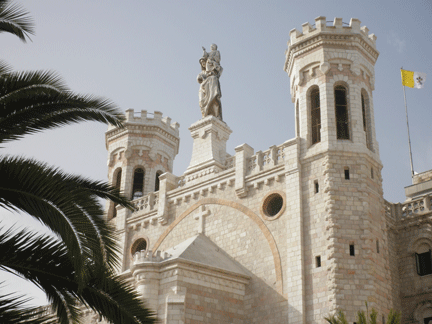
Notre Dame |
||
| We took a taxi to the Mount of Olives. At the top, we got out and looked down the hillside at row after row of the white cement
coffins in the Jewish cemetery. Our guide told us that most of the graves belonged to Americans and that it costs as much as $35,000 to be there.
The cemetery was swarming with Haredim men and boys, some who looked as young as 10 or 11, dressed in black suits, white shirts, black brimmed hats, with tzitzit hanging from the Tallit that they wear under their clothes. The Haredim are ultra-Orthodox and non-Zionist Jews. They believe that a Jewish state will only be worth celebrating after the Messiah comes and Jewish law rules the country. They are here to make Israeli society more religious, to open yeshivas to study the Torah, and to be in the promised land when the Messiah comes. They have no interest in Israel's nonreligious issues and believe that present events are simply unfolding as they should in preparation for the Messiah. The Haredim not only look different. They are different. They speak Yiddish, not Hebrew, and they don't celebrate Israel's Independence Day. They do not greet you, or smile, or even look at you. It's as if to them you don't exist. |
||
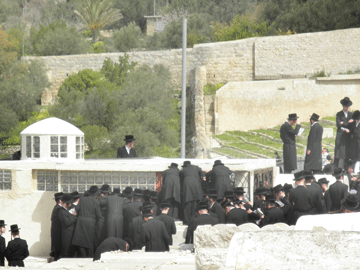
Haredim at Jewish Cemetery on Mount of Olives |
||
| We drove down the Mount of Olives road to the Garden of Gethsemane, the road where Jesus walked on Palm Sunday. Cynthia and I wanted to walk down, but we were committed to the taxi at that point and agreed to come back. | ||
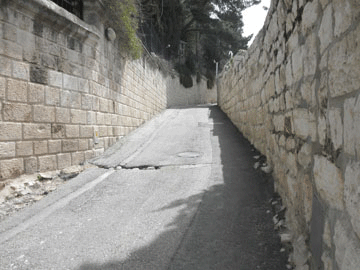 |
||
| The driver stopped at the bottom of the hill and we got out, staring at the place where Jesus prayed during the night of the Last Supper. It's small and beautiful with ancient olive trees. No one is allowed entry, but we stood close enough to the gate. It was quite moving to be there. | ||
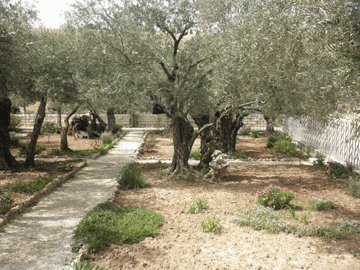 |
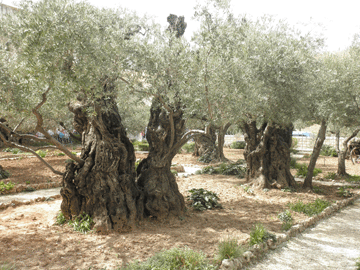 |
|
| The Garden of Gethsemane | ||
| Dome of the Rock
The Dome of the Rock is a Moslem shrine. Like the Ka'ba in Mecca, it is built over a sacred stone that is believed to be the place from which the Prophet Muhammad ascended into heaven. It is the oldest Islamic monument standing today and has the oldest surviving mihrab ( a niche indicating the direction of Mecca) in the world. It is also the Biblical site of Mount Moriah, where God asked Abraham to offer his son Isaac as a sacrifice, as recorded in Genesis 22:"After these things God tested Abraham, and said to him, "Abraham!" And he said, "Here am I." He said, "Take your son, your only son Isaac, whom you love, and go to the land of Moriah, and offer him there as a burnt offering upon one of the mountains of which I shall tell you." This important event in the life of Abraham is known to the Jews as "the Akeda" or "the binding of Isaac." We were not allowed to enter the Mosque built around the rock, because it is now open only to Moslems. We walked around the grounds, which was full of people going in and out of the Mosque, grandmothers sitting together in the sun, and children playing, shouting and running all around, seemingly unsupervised. Not a helicopter parent in sight. |
||
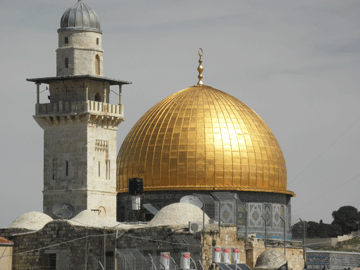
| 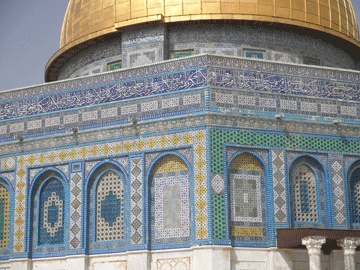
| |
| The Dome of the Rock | ||
| We went back to the Old City and had lunch in a little Jewish café till it was time for our 4:15 English language Kotel tour of the excavations under the West Wall. While sitting at the cafe, a group of Israeli soldiers walked by and exchanged a few words with us. They spoke excellent English. One's father lives in Texas. Cynthia and I had our pictures taken with them. | ||
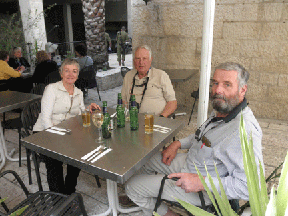
Cafe in the Jewish Section |
||
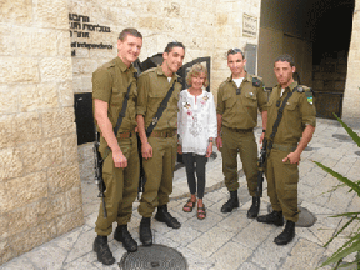 |
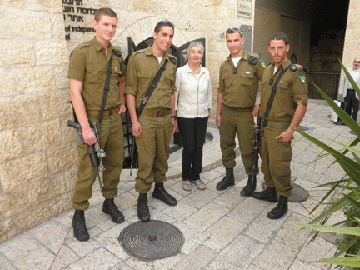 |
|
| Kotel Tunnels.
We had a wonderful Israeli guide, a young woman, for our tour through the Kotel Tunnels. It is an extraordinary experience to view, from a spacious, air-conditioned, well-lighted glassed-in walking path, the ancient wall that extends the Western Wall as far as the Temple Mount, as well as other treasures that are being rediscovered from a Jerusalem that existed 2000 years ago. |
||
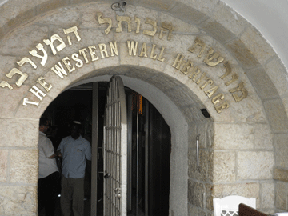
Kotel Tunnel Entrance |
||
| Every minute in Jerusalem seemed wonderful to me. We'd walked miles and seen sights of a lifetime in two days. The next day we'd leave for Amman, Jordan and the day after that we'd fly to Cairo. I was glad we'd be coming back to Jerusalem for the last part of our trip. | ||
| TOP | ||
| We took a taxi from Jerusalem to the Jordanian border. On the way we saw a few Bedoin camps. We stopped at one, and the children ran over to our car, with their hands out. Sadly, they know how it works. Let the tourists take our pictures and they'll give us money. | ||
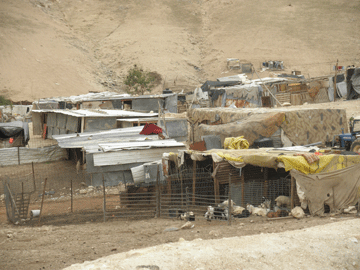
Bedoin Camp |
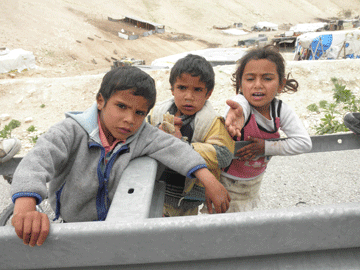
Bedoin Children |
|
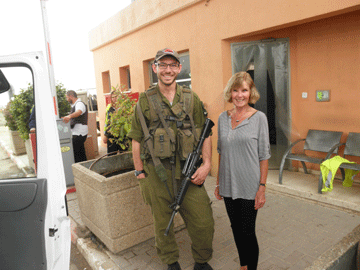
Another friendly Israeli soldier |
||
| We stopped first at the Israeli border, where they examined our passports and checked our luggage. The Israeli soldier at the border was very friendly. Our driver left us at a Jordanian checkpoint, where we entered a waiting room, went though security and waited for a bus to take us into Jordan. | ||
| Eilat, Israel. Monday, March 26, 2012
We crossed over the Israeli border and took a taxi into Eilat. On the strip of glitzy hotels, we chose the modest-looking Riviera Club, dropped our luggage, and went for a walk along the waterfront by shops, amusment rides, sidewalk cafes, and restaurants. We had to dine at a sea-food restaurant called Boston. It was a beautiful, warm evening. We sat outside. The food was excellent. |
||
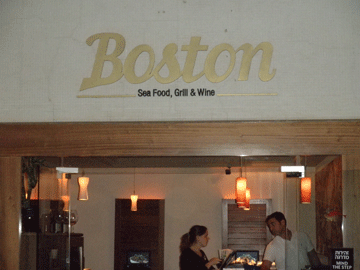 |
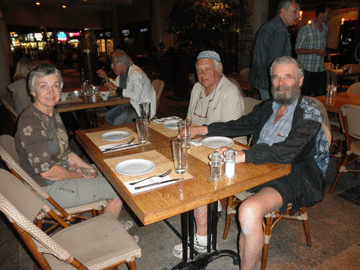 |
|
| TOP | ||
| We rented a car in Eilat and took Rt. 90 North. Charlie was back in his element, behind the wheel, speeding along a highway in a brand new place. Our view for many miles was rocks and sand. Then, just before Masada, we saw a real oasis in a real desert, the Dead Sea. | ||
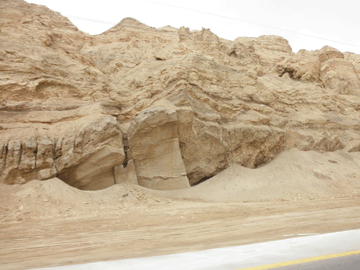 |
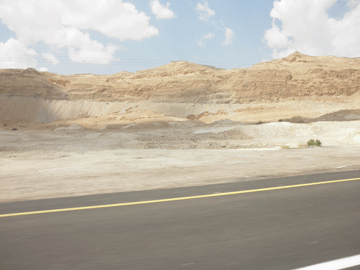 | |
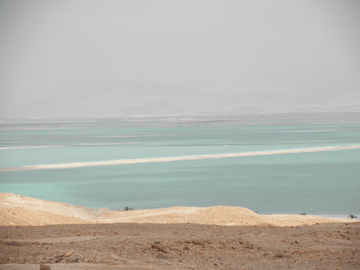 | ||
| Masada and the Dead Sea
Our first stop was Masada. The story of Masada is extraordinary. The Jewish defenders of the mountain, 967 Men, women, and children, committed mass suicide rather than be taken into slavery by the Romans. Their one goal: to live freely as Jews. The held the Romans off for three years. The Romans had surrounded the mountain and built a wall that eliminated any possible escape. The built a ramp that led to the peak and would transport their war machines. The climb to the top along the Snake Trail and up the steps took 45 minutes. As we climbed, we met several large groups of Israeli school children coming down. Exuberant and rushing past, they were oblivious to a person in their way, so I stopped and waited near the inside wall till each group passed. One boy stopped and asked me if I spoke English. Then he asked where I came from. When I told him, his face lit up, and he said, "I will go to America someday." He was a very sweet contrast to his fellow students. After conquering Mt. Sinai, Cynthia, Bill, and I had no doubts about our ability to climb this mountain rising from the Judean Desert. | ||
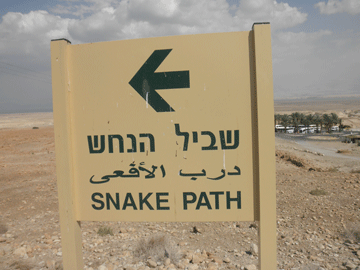 |
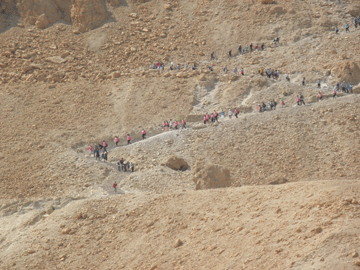 |
|
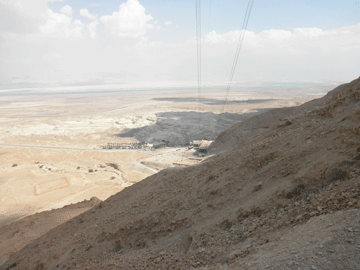 |
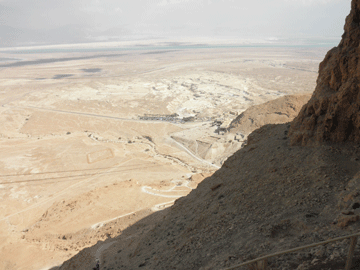 |
|
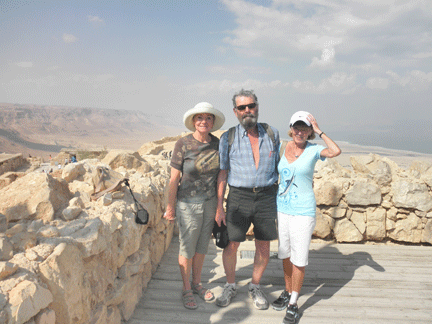
We did it again! |
||
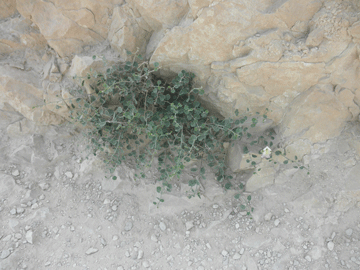 |
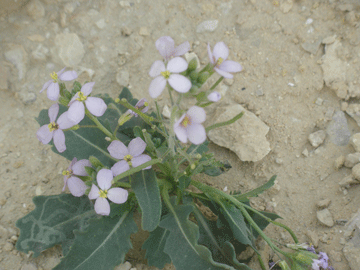 |
|
| On this climb, we had time to enjoy the wonder of a flower from the stone. | ||
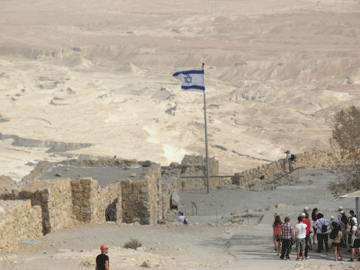 |
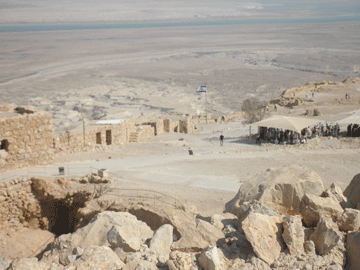 |
|
| I really enjoyed this climb. At points it was difficult. My legs and feet never hurt as they did climbing Mt. Sinai, but I was out of breath a few times. The big difference between the two climbs was that here I always knew I would get to the top, so reaching this summit wasn't the same big thrill. Sitting at the top was a group of senior citizens who had got to the top on the cable car. They were surprised that I had walked, especially when I told them my age. I think they were a few years younger. I felt very proud of my accomplishment. We took the cable car down. | ||
| Our second stop was the Dead Sea. Cynthia and Bill went for a swim. It was very windy and a little chilly, and I couldn't get my leg wound wet, so I just watched and took a few pictures. | ||
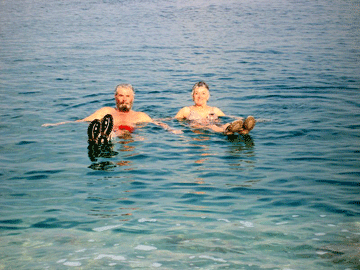 |
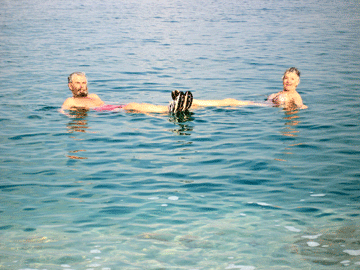 |
|
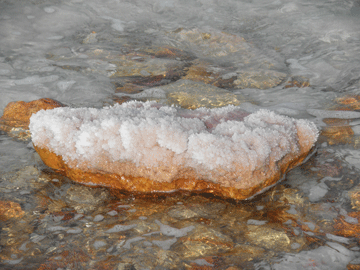 |
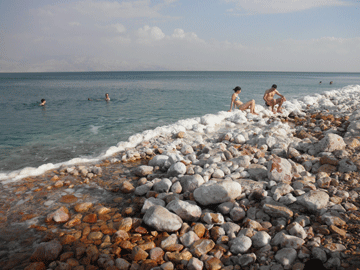 |
|
| We continued north on Rt. 90 with the Judean Desert on our left and the Dead Sea on our right until we came to Rt. 1 toward Jerusalem and Tel Aviv. We decided to take that route east, and take Rt. 2 north because we were cautioned not to drive north along Syria's western border. We passed Jerusalem and drove through Tel Aviv and decided to stop in Netanya, north of Tel Aviv to find a place for the night. After entering Netanya and going around the same rotary several times, finding no hotels at all, we finally saw Q Hotel's big red sign glowing in the distance. It is a barebones motel, but we didn't care. We were hungry and asked the desk clerk where the restaurants were. Usually, in a place like this, that doesn't work because they invariably send American tourists to a fast-food strip. However, we followed his directions, found Rubenstein's Restaurant, and it was excellent. | ||
| TOP | ||
| Haifa
We were hoping to go to the Baha'l Gardens, but they are closed on Wednesday. So, we walked along Ben-Gurion Avenue, leading down from the Gardens into the German Colony. The colony was established in 1869 by a Christian society that aimed to help Palestine get ready for the second coming of Christ. Germans lived in the Colony until WWII, when the British threw them out as suspected Nazi collaborators. They built seven colonies in Palestine and are credited with developing the country in the late 1900s, providing improved methods of transportation, technology and agriculture. | ||
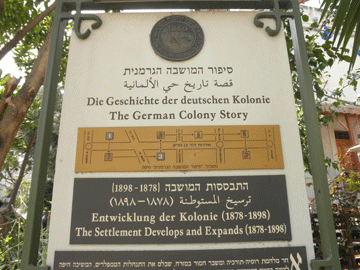 |
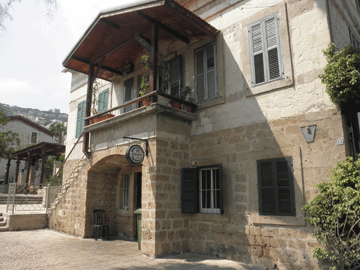 |
|
| The German Colony | ||
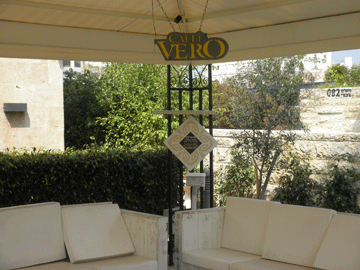 | ||
| Nazareth
We arrived in the bustling, crowded city of Nazareth. Noticable on the streets was the unusually large number of young people of all ages. Stopping several times to ask directions to the Greek Orthodox Church of the Annunciation, we got the "No English" response, which was surprising because the church standing at the top of a hill is huge, and we were obviously tourists looking for the one tourist attraction in their neighborhood. Looking back, I'm wondering if that had anything to do with our Israeli number plates. It was worth the search because the church was established where the Annunciation took place, where the Archangel Gabriel told Mary that she would be the mother of Jesus. The Greek Orthodox tradition holds that this event occurred while Mary was drawing water from the well in Nazareth. Water from the spring still runs inside the apse of the church and also fed the adjacent site of Mary's Well, located 150 yards (140 m) away. The cave in the Church was part of Mary's house. Huge bronze and copper doors depict scenes from Jesus and Mary's life. Icons dedicated to Mary are gifts from around the world, the mosaic wall a gift from Italy. The huge dome is an upside-down lily. | ||
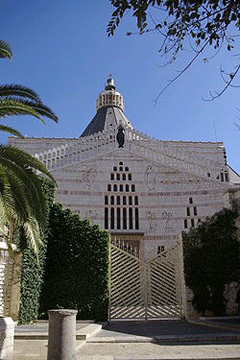
Greek Orthodox Church of the Annunciation |
||
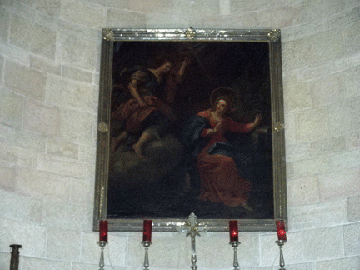
The Annunciation |
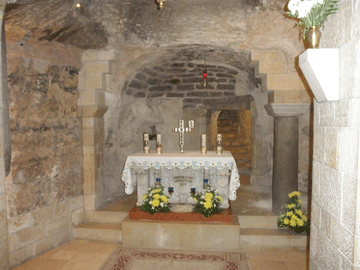
Mary's Cave |
|
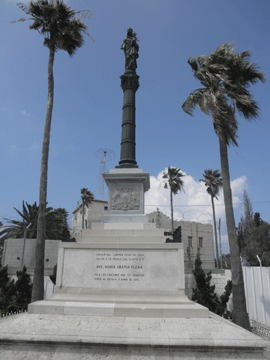
Donation from Chile |
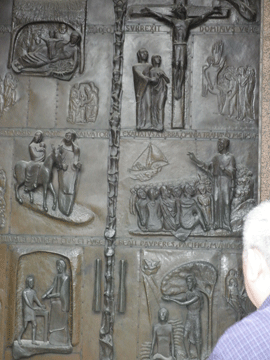
Bronze door with scenes from Mary and Jesus's life |
|
| Nazareth Village
After visiting the Church, we went to Nazareth Village and joined a tour with a group from Holland. Nazareth Village recreates a 2000 year old farm and Galilean village and is located 500 meters from where Jesus grew up. We walked through the village on a path, passing goats grazing, observing a carpenter carve a cross and a weaver make yarn. She explained that in Mary's time, they used vinegar to make an orangey colored yarn, pomegranate for red, walnut for tan, saffron for yellow, and snails for varied colors. (Since it took 1000 snails for 1 kilo of yarn, this yarn was for the very wealthy only.) We saw the cistern necessary to every home and the caves where they stored wheat and other supplies. Most memorable was our visit to the Synagogue. A man from the Dutch group read from Luke 4: 16-32, which says "Do not put your trust in princes, in human beings, who cannot save. When their spirit departs, they return to the ground; on that day their plans come to nothing." Then they all sang Psalm 146: "Praise the Lord." | ||
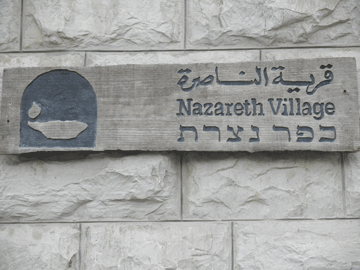 |
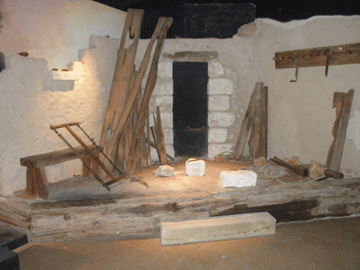 |
|
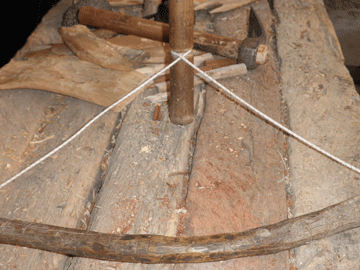 |
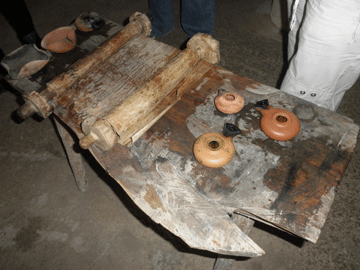 |
|
| Life in a Nazareth village 2000 years ago. | ||
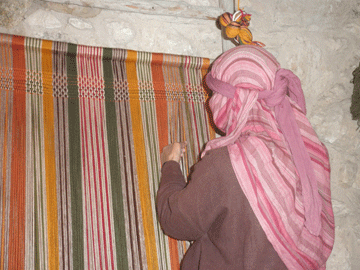 |
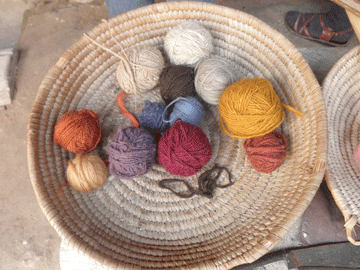 |
|
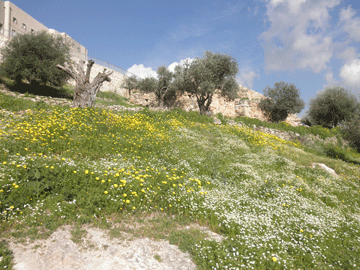 |
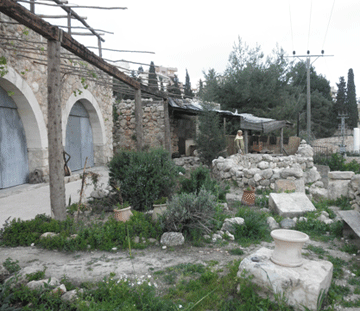 |
|
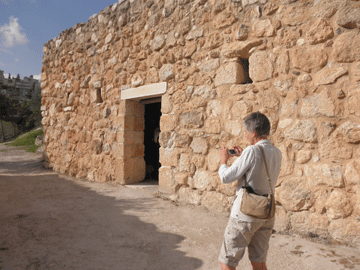
The Synagogue |
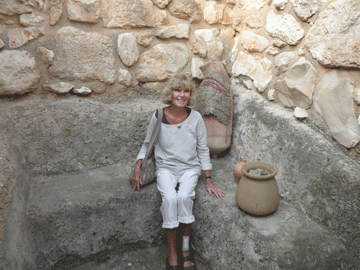
Quiet corner in ancient Nazareth |
|
| TOP | ||
| Tiberius. Wednesday, March 28, 2012
The Arbel Guest House We stopped at a small guest house buried in a tiny village called Arbel about 10 minutes from Tiberias. Its five units and dining room are decorated with loving care and spotlessly clean. The grounds are quaint and lovely. The owners are an older couple and have owned the place for years. He cooks and she does everything else. The dinner and breakfast were both excellent, delicious, abundant, and attractively presented. However, the woman was not welcoming. When Cynthia and I knocked on the door and asked if we could get a room, she looked us up and down and didn't look pleased at what she saw. She closed the door and told us to wait. Five minutes later she came back. Later, in the dining room, she reprimanded Charlie severely. He had asked her for something to nibble on before we ordered dinner. Her response? "This is a dining room. We serve dinner. If you wanted hors d'oeuvre, you should have had it in your room. Why do you think we put a kitchen there?" Then Charlie asked if we could have some bread. She repeated what she'd said the first time. So we gave up and looked at the dinner menu. I saw bread listed for 14 NIS (New Israeli Shekel), so I ordered that. She brought the bread but she didn't look pleased. Evidently, the bread was to be ordered along with the meal. However, her husband came over to our table after dinner and was friendly enough. | ||
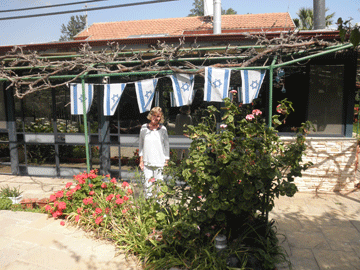 |
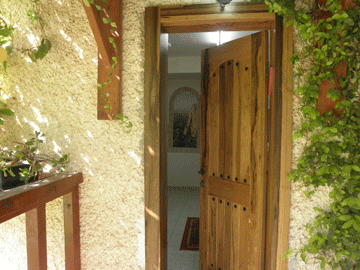 |
|
| The Arbel Guest House | ||
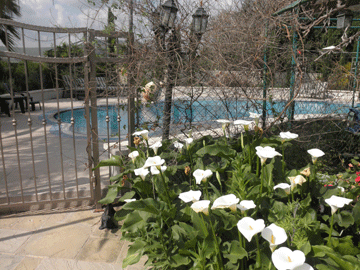 |
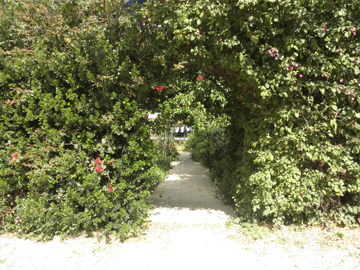 |
|
| Yigal Allon Museum. Thursday, March 29, 2012
The museum is on the grounds of Kibbutz Ginosar. Founded in 1937, the Kibbutz is noted for its out-of-season fruit and vegetables. Displayed in the museum is an ancient boat that in 1986 was pulled from the mud along the northwestern shore of the Sea of Galilee. The boat appeared after a great drought when the waters of the lake had receded and was discovered by two brothers, Moshe and Yuval Lufan, second-generation fishermen from Kibbutz Ginosar. The brothers reported that when they found the boat, a double rainbow appeared in the sky. The Galilee Boat is the type of boat that was used on the Sea of Galilee for both fishing and transportation across the lake during the time of Jesus and his disciples. I bought a small cross at the museum shop. | ||
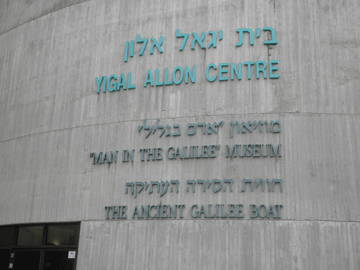 |
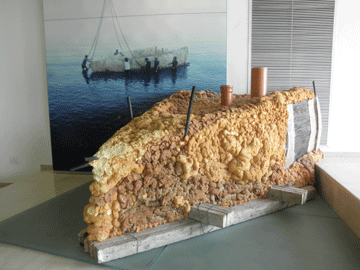 |
|
| The 2000-year-old boat | ||
| TOP | ||
| Tabgha. Thursday, March 29, 2012
Church of the Multiplication of the Loaves and Fishes. According to the Gospel of John, Chapter 21, Jesus appears to his disciples for the third time after his resurrection on the shores of the Sea of Galilee. The night before, Peter and several other disciples had sailed out on the lake to fish, but caught nothing. In the morning, a man appeared on the shore and called out to them to throw their net on the right side of the boat. Doing so, they caught so many fish they couldn't drag the net back into the boat. At this point Peter recognizes Jesus, and promptly jumps out of the boat to wade to shore to meet him. The other disciples follow in the boat, dragging the net behind them. When they land, Jesus has prepared a charcoal fire for the fish and provided bread, and they have breakfast together (John 21:9). | ||
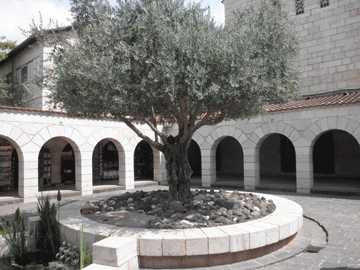
| 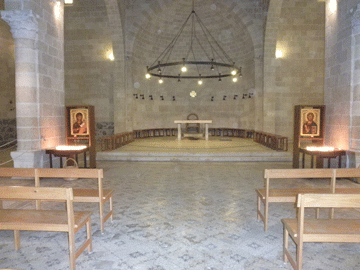 |
|
| Church of the Multiplication of Loaves and Fishes | ||
| Church of the Primacy of St. Peter
The rock in front of the altar, the Mensa Christi, is believed to be where Jesus and his Disciples had their fish breakfast. The Franciscans built this church in 1933 to commemorate the spot where the resurrected Jesus conferred the Church leadership on Peter. After breakfast, Jesus reinstated Peter (after his three-time denial of Jesus at the crucifixion) with the words "Feed my sheep" (John 21:15-19). According to the Catholic Church,this is what gives the Pope (as the successor of Peter) authority over the worldwide Church. A Franciscan priest was sitting outside the Church reading. I stopped, wondering if I should interrupt him and ask him to bless the cross I had just bought at the Boat Museum. He looked up at me and smiled, so I took out my cross and asked him if he would bless it. He did and then blessed me. | ||
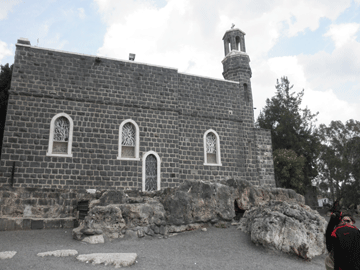
Church of the Primacy of St. Peter |
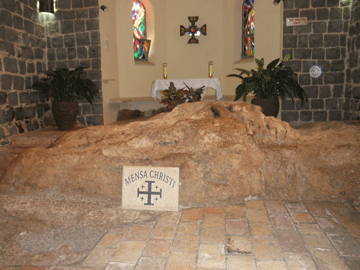
Mensa Christi (Christ's Table) |
|
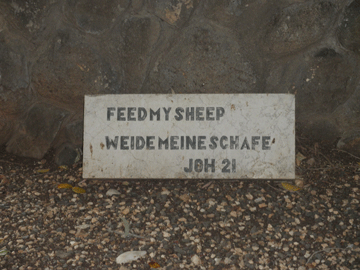 |
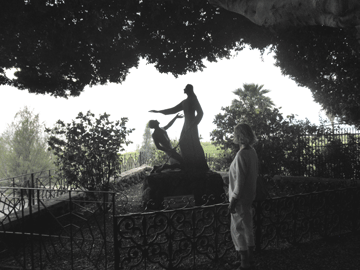 |
|
| The plaque on the statue says, Feed My Sheep. Behind it, the hill slopes down to the Sea of Galilee. | ||
| TOP | ||
| Capharnaum. Thursday, March 29, 2012
According to Christian belief, the village of Capharnaum was the home base of Jesus during the most influential period of his Galilean ministry. It's where he preached at the syagogue, healed the sick, and recruited his first disciples, Peter, Andrew, James, and John, local fishermen, and Matthew, the tax collector. In 1894, the Franciscans purchased the site and began restoring the ancient synagogue and church. | ||
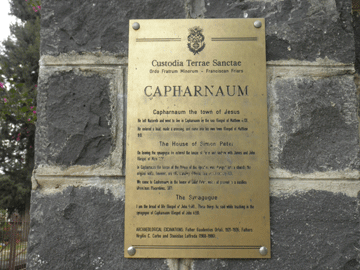 |
||
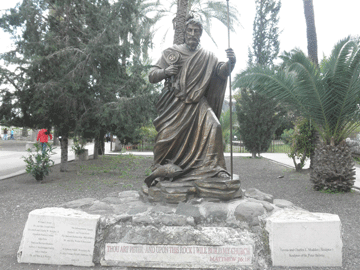 |
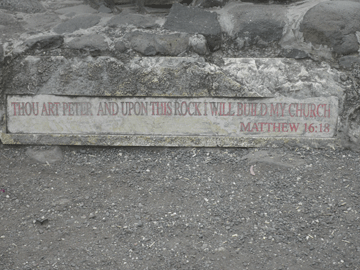 |
|
| Statue of Saint Peter | ||
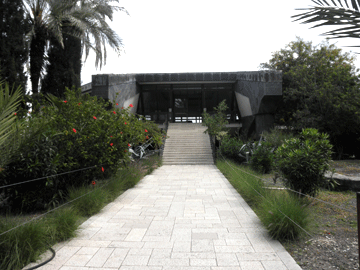 |
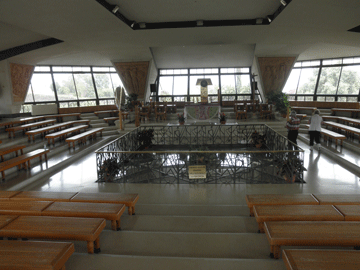 |
|
| Catholic Church built over the home of Saint Peter | ||
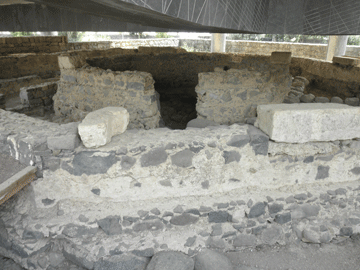 |
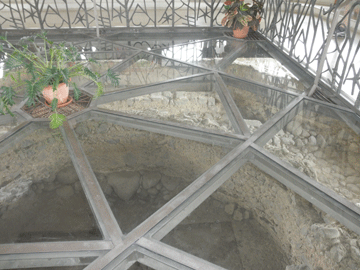 |
|
| Ruins of Saint Peter's home under the Church | ||
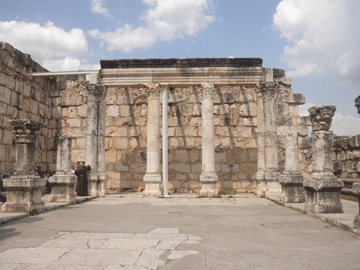
The ancient synagogue |
||
| Capharnaum. Thursday, March 29, 2012
Monastery of the Twelve Apostles An earthquate destroyed the city, but archeological excavations show that there was a large orthodox monastery here. At the end of the 19th century the Greek Orthodox Patriarchate of Jerusalem purchased a plot of land on the ruins of the ancient city of Capernaum and began to construct a monastery. In 1925 the Church of the Twelve Apostles was built. Services were held in the church until the founding of the state of Israel in 1948. According to the U.N. convention and the new borders, the monastery turned out to be on no man's land. Therefore, there was no more access to the monastery for local Christians or pilgrims and the monastery fell into decay. In 1969, two years after the six-day war, the Israeli army returned the monastery to the Greek Orthodox Patriarchate of Jerusalem. | ||
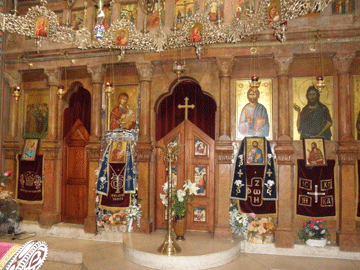 |
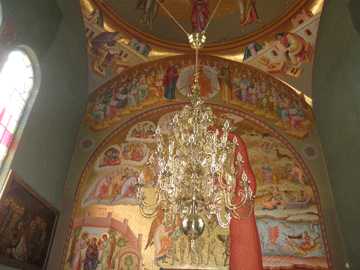 |
|
| Monastery of the Twelve Apostles | ||
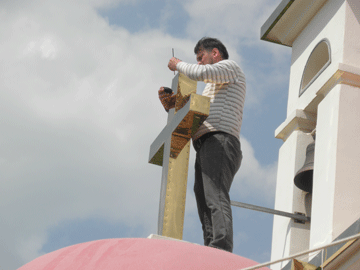
Painting one Cross |
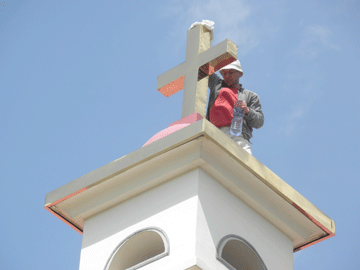
Polishing the Other |
|
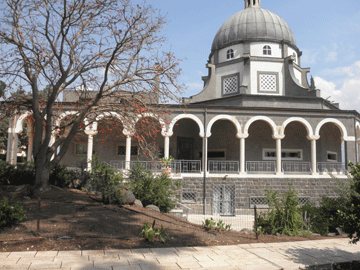
Monastery Museum |
||
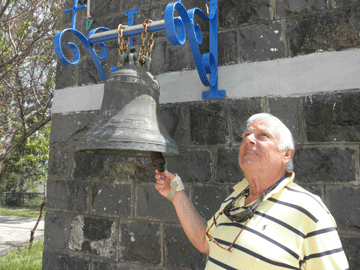 |
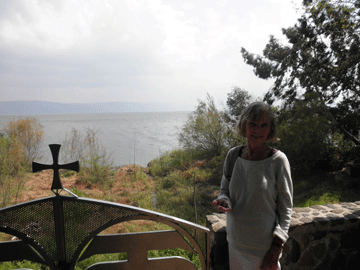 |
|
| TOP | ||
| Capharnaum. Mount of Beatitudes | ||
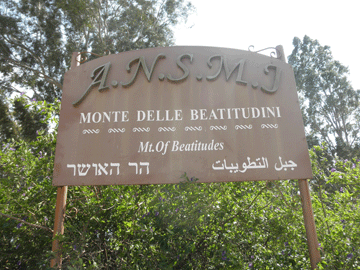 |
The Beatitudes from the Sermon on the Mount. Matthew, Chapter 5
Blessed are the poor in spirit: for theirs is the kingdom of heaven. Blessed are they that mourn: for they shall be comforted. Blessed are the meek: for they shall inherit the earth. Blessed are they which do hunger and thirst after righteousness: for they shall be filled. Blessed are the merciful: for they shall obtain mercy. Blessed are the pure in heart: for they shall see God. Blessed are the peacemakers: for they shall be called the children of God. Blessed are they which are persecuted for righteousness' sake: for theirs is the kingdom of heaven. |
|
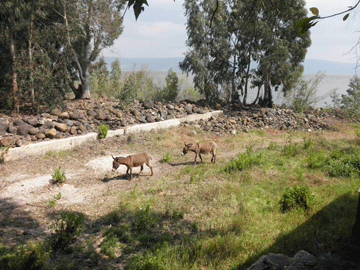 |
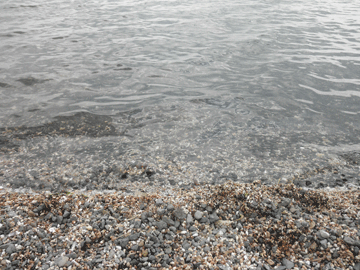 |
|
| On the shores of the Sea of Galilee | ||
| TOP | ||
| Golan Heights Winery. Thursday, March 29, 2012
We were ready for a break, so we drove to the Golan Heights Winery in the small town of Katzrin, high up on the Golan Heights. After a short tour came the wine-tasting. First, we tasted a white wine, Golan Sion Creek White, which is described as a combination of Sauvignon Blanc, Gewurztraminer, and White Riesling. That is best served with light foods, such as starters or Thai dishes. Next we tasted a red wine, Gamla Sangiovese, which would go well with boldly-flavored foods like grilled lamb chops or steak in pepper sauce. Our third wine was Yarden Muscat, a dessert wine fortified by the addition of oak-aged brandy, to be served with carmeized apple pie or cheesecake. The Golan Heights Winery was founded in 1983 and produces award-winning wines, marketed under the labels "Yarden", "Gamla" and "Golan." My favorite is the Golan Sion Creek White. As a gift, we each got a box to wrap our glass in, and, of course, we bought a few bottles of our favorites. | ||
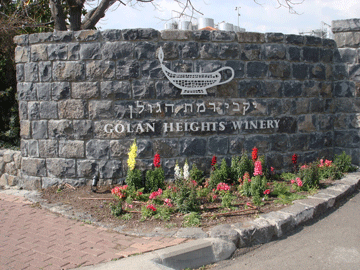 |
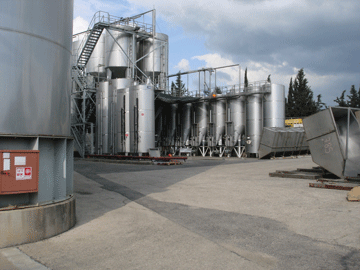 |
|
| Golan Heights Winery | ||
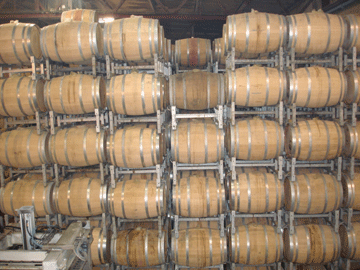 |
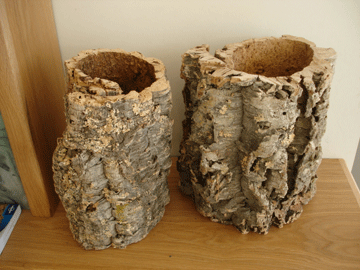 |
|
| TOP | ||
| Tsfat. Carmel Hotel. Thursday, March 29, 2012
Tsfat or Safed, a town high in the mountains in the north of Israel, is associated with the element of air, and it is said that "the air of Tsfat makes one wise." The Zohar, a Jewish mystic, stated that the air of Zefat is the purest in all of Israel. One Rabbi moved his community from Tsfat because he said that the air in Tsfat is so pure and holy that he kept hearing heavenly voices calling through the night and he couldn't get a decent night's sleep. We stayed at the Carmel Hotel, with the friendliest hotel owner I've ever met. It was a cold, rainy night, the hotel wasn't heated, and I was shivering. He said,"You're cold? Take my coat," and he took his coat off and put it around my shoulders. His name is Solomon. He wanted to know all about us, where we were from in America, whether we were liberals (only some of us, we told him), and told us that Israel is our 51st state. He introduced us to his family and said we had to eat at his son's restaurant downstairs because it was the best in town. He was so persuasive and the air was so pure that Charlie was wise and agreed to eat there instead of roaming around town to find his own eating place. Solomon was right. We loved the restaurant. |
||
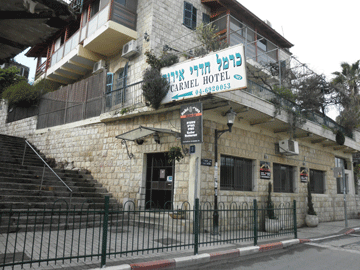 |
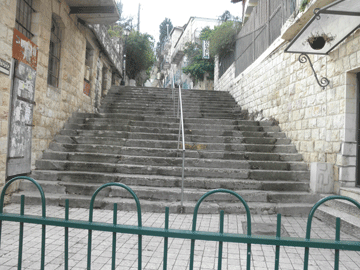 |
|
| Tsfat. Carmel Hotel | ||
| TOP | ||
| Back to Jerusalem. Friday, March 30, 2012
Whenever I'll think of our drive North on Route 90, I'll see only rocks and sand. Whenever I'll remember driving everywhere else in Israel, I'll see yellow wildflowers. I'm not sure how long they bloom, but I know that in March they are spectacular. |
||
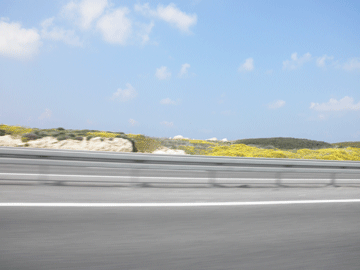 |
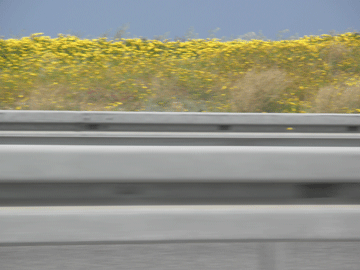 |
|
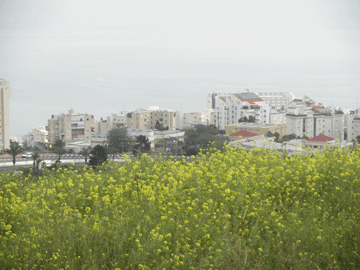 |
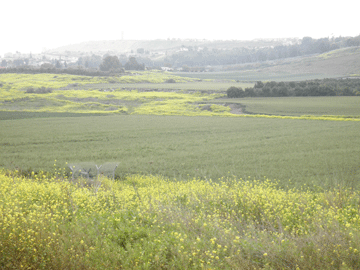 |
|
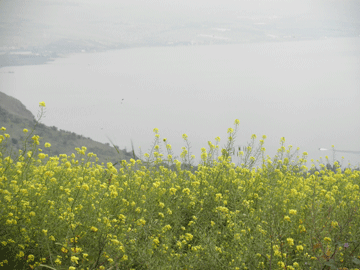 |
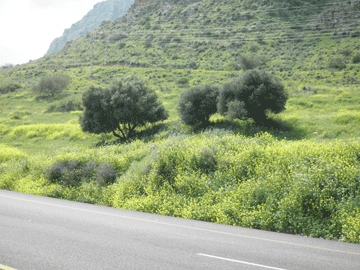 |
|
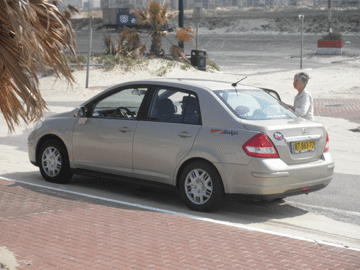
Our Israeli car |
||
| TOP | ||
| Jerusalem. Friday, March 30, 2012
Back in Jerusalem It felt good to return to familiar Jerusalem. We checked into the hotel we had reserved online the night before in Tsfat, which turned out to be a good choice. Although the room was tiny and the shower microscopic, it had WiFi, a pleasant breakfast room with free tea and coffee all day, and was close to the tram, the shopping district,and the good restaurants. Also, from the Palatin we could walk anywhere we wanted to go. Charlie and Bill had to go back to Tel Aviv to return the car because the Jerusalem Budget Rentals office was closed. While they were gone, Cynthia and I set out with a goal. We each had a granddaughter making her First Communion, and we wanted to buy a cross. We had already looked in the Old City and did not find what we wanted, so we were eager to shop in our neighborhood, where we had noticed several jewelry shops. We walked down the right side of Jaffa Street, down to Ben Yehuda Street, stopping at one shop at the time, looking first in the window, then going inside. No place had a cross in sight. So we walked back on the other side of Jaffa Street to keep trying. Finally, on the way out of the last jewelry shop, we decided to go back inside and ask the man if he had any crosses. He smiled, bent down and reached under the counter and came up with a tray of crosses. He was very pleasant and helpful. We found what we'd been looking for and made our purchases. This experience was puzzling to us. Many Christian tourists come to Jerusalem. If a shop owner has crosses to sell, why does he not have one on display? I told all this to my grandson Alexander, who three summers ago spent two weeks in Jerusalem on a tour with other high school kids. He said they met a group of Israeli kids and they started hanging out together. When the Israeli kids found out that the American kids were Jewish, they left, didn't want to hang out with them anymore. | ||
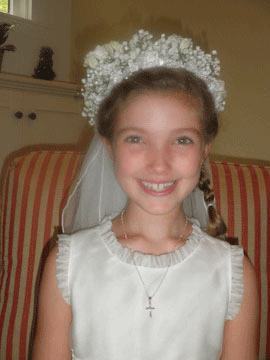
Lindsey, wearing her cross from Jerusalem. |
||
| A few weeks after we were back in the States, 60 Minutes aired "Christians of the Holy Land," by correspondent Bob Simon. He stated that the "exodus from the Holy Land of Palestinian Christians could eventually leave holy cities like Jerusalem and Bethlehem without a local Christian population. Why are they leaving?" | ||
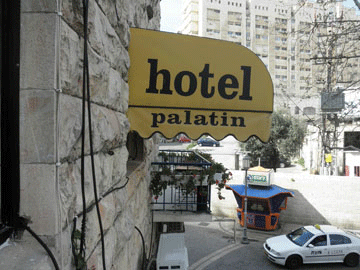 |
||
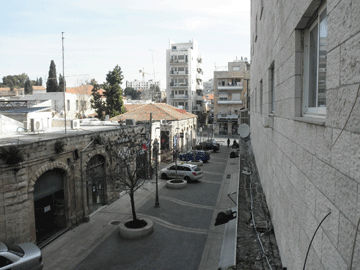
View to Jaffa Street |
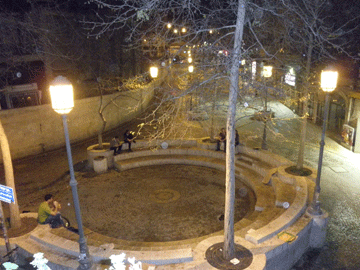
View from hotel room window |
|
| Jerusalem. Friday Evening, March 31, 2012
They got back late from Tel Aviv, so we couldn't go back to the Wall, as we had planned. Charlie and I walked to the Restaurant area, off Jaffa Street. We ended up at the Sea Dolphin (Dolphin Yam). It was attractive, comfortable, and busy, and the food was excellent. Right away they bring about ten mezza (appetizers and little salads) and wonderful warm pita bread. And they refill each dish as soon as it's empty. Of course, we had fish for the main course and it was delicious. We're beginning to believe that there is no such thing in Israel as a bad restaurant. And the Sea Dolphin serves dinner until 3 a.m! | ||
| TOP | ||
| Bethlehem. Saturday, March 31, 2012
Although Bethlehem is only 7 miles from Jerusalem, it's difficult to get there because it's surrounded by a wall. Also, we could not drive there on our own. We went by taxi, and that turned out very well. Our driver was also an excellent guide. | ||
| Bethlehem. Saturday, March 31, 2012
In 326, Constantine and his mother Helena commisioned a church to be built over the cave where Jesus was born. Dedicated on May 31, 339, the church had an octagonal floor plan and was placed directly above the cave. In the center, a 4-meter-wide hole surrounded by a railing provided a view of the cave. Portions of the floor mosaic survive from this period. In 1852, shared custody of the church was granted to the Roman Catholic, Armenian and Greek Orthodox churches. The Greeks care for the Grotto of the Nativity. | ||
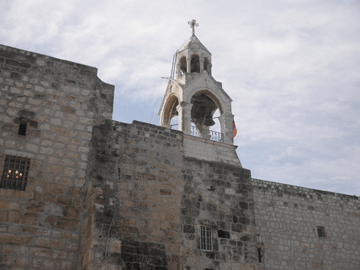 |
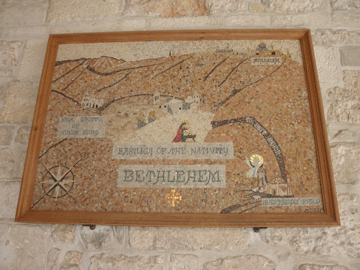 |
|
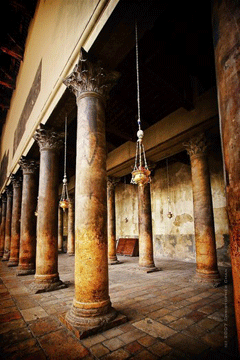
Side wall of the ancient basilica |
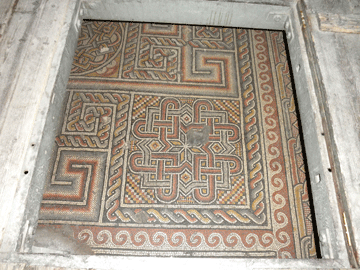
Floor Mosaics from the 4th century basilica |
|
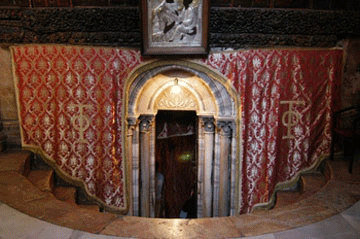
Entrance to the Grotto of the Nativity |
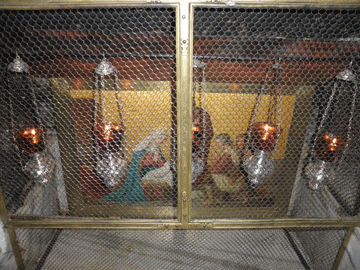
Chapel of the Manger |
|
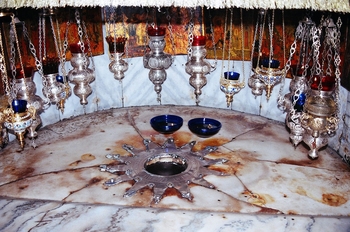
The birthplace of Jesus |
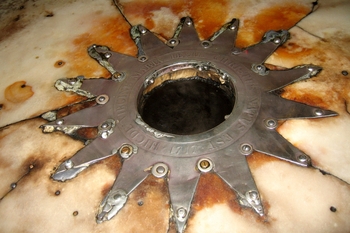
A star marks the exact spot. |
|
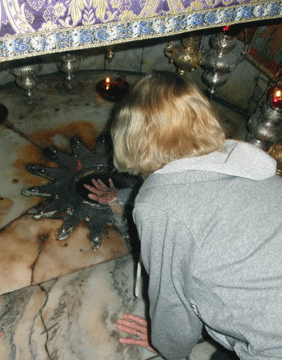 |
||
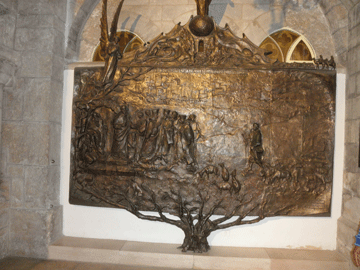
"I am sending you to Jesse of Bethlehem, for I have chosen myself a king from among his sons." (1 Samuel 16:1) The sculpture represents the visit of the Phrophet Samual to Jesse (seated and surrounded by seven of his sons). On the other side of the relief we see David, the youngest son arriving with his flock. The presence of the angel is to remind us that the promises made to David have been fulfilled with the incarnation of the Son of God. The tree symbolizes the geneology of Jesus Christ, who is represented as King of the Universe and is at the highest place in the sculpture. His Holiness, Pope Benedict XVI, during his pilgrimage to Bethlehem, blessed this work on the 13th of May, 2009. Sculpture by Czeslaw Dzwigaj |
||
| Bethlehem. Saturday, March 31, 2012
Shepherd's Field. The Roman Catholics and the Greek Orthodox each have their own Shepherds' Field. The Roman Catholic site features a Franciscan Chapel designed to resemble the shepherds' tent while the Greek Orthodox site features a 5th century church built over a cave. On the night of Christ's Nativity, this underground church was the cave of the shepherds, who heard the angelic proclamation "Glory to God in the highest, peace on earth and good will to men." Luke 2-14. This cave was one of the many churches built by Saint Helena in the year 325 AD. The cave functioned first as a shelter, then as a tomb of the shepherds, and has been treated as such by Christians since the 4th century. | ||
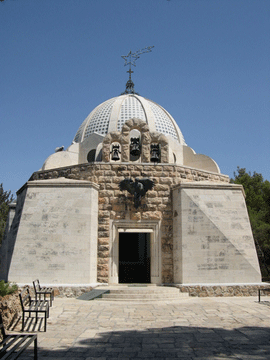 |
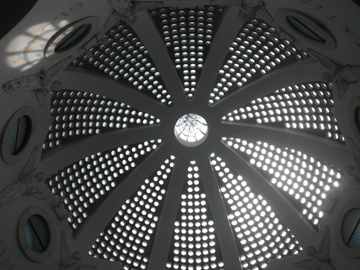 |
|
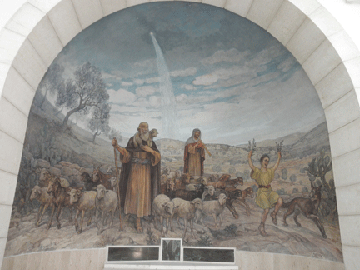 |
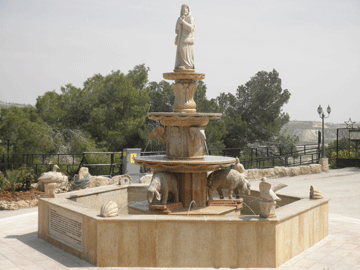 |
|
| TOP | ||
| On the Road to Jericho. Saturday, March 31, 2012 | ||
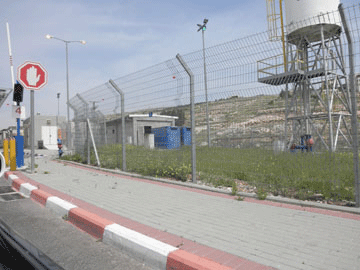
The Checkpoint |
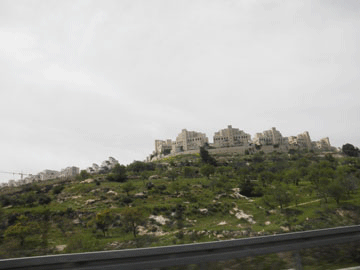
The Settlements |
|
| Jericho. Saturday, March 31, 2012
Mount of Temptation and Monastery of the Qurantel About 3 km northwest of Jericho is the summit of Mount of Temptation, where Jesus spent forty days and forty nights fasting and meditating during the temptation of Satan. A Greek Orthodox monastery was built in the 6th century over the cave where Jesus stayed. This spot is another of the holy sites identified by Queen Helena in her pilgrimage of 326 AD. | ||
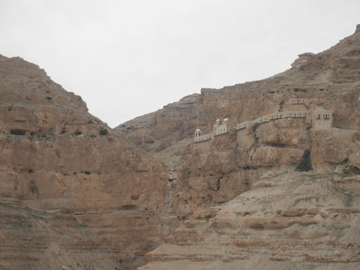 |
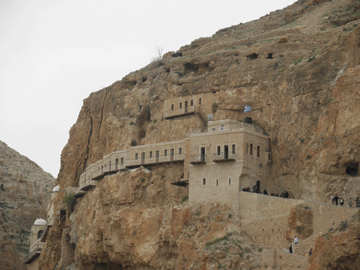 |
|
| Monastery of Temptations | ||
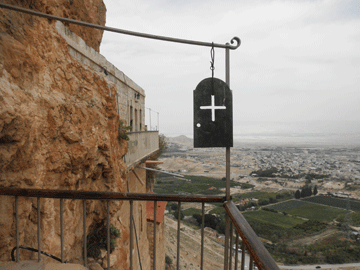 |
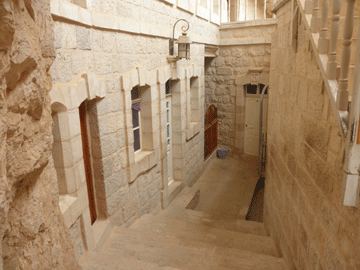 |
|
| Because Charlie speaks Greek, we were allowed inside. | ||
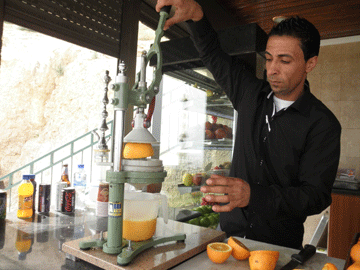 |
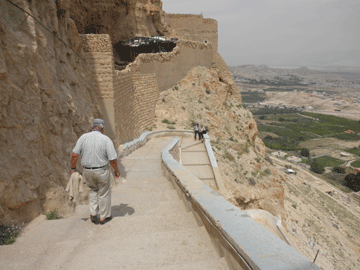 |
|
| Fresh orange juice and then the walk down. | ||
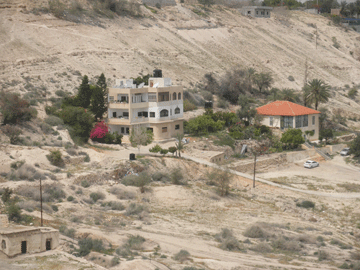 |
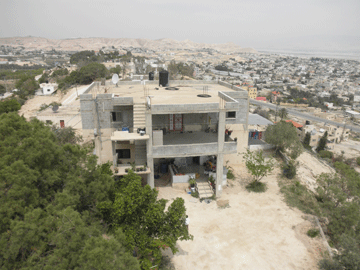 |
|
| Views from the Cable Car | ||
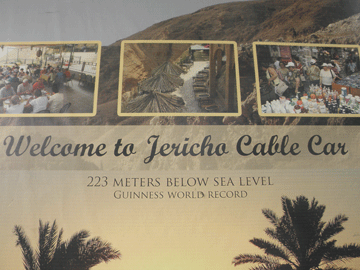 |
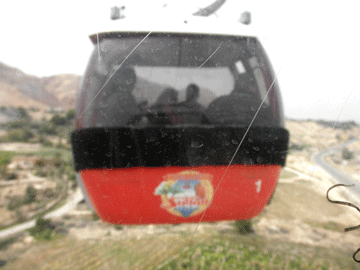 |
|
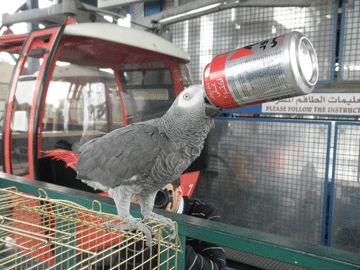
Birds are smart in Jericho. | ||
| Jericho. Saturday, March 31, 2012
Jericho Big Dig Mark Anthony supposedly gave Jericho to Cleopatra in 35 B.C. as a wedding present. According to the Bible, Jericho was the first city the Israelites captured after wandering 40 years in the desert. At their shouts of joy, the walls came tumbling down. An effort is underway to uncover the ancient city. | ||
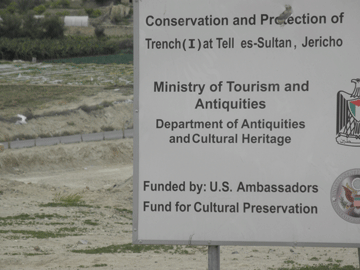 |
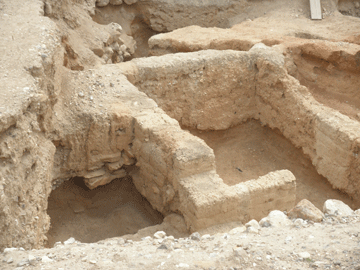 |
|
| The Big Dig | ||
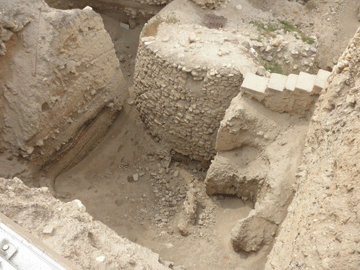 |
||
| Jericho. Saturday, March 31, 2012
Zacchaeus the Tax Collector Jesus was passing through Jericho. There was a man named Zacchaeus. He was a chief tax collector, and he was rich. He was trying to see who Jesus was, and couldn't because of the crowd, because he was short. He ran on ahead, and climbed up into a sycamore tree. When Jesus came to the place, he looked up and saw him, and said to him, "Zacchaeus, hurry and come down, for today I must stay at your house." He hurried, came down, and received him joyfully. When the people saw it, they all murmured, saying, "He has gone in to lodge with a man who is a sinner." Zacchaeus stood and said to the Lord, "Behold, Lord, half of my goods I give to the poor. If I have wrongfully exacted anything of anyone, I restore four times as much." Jesus said to him, "Today, salvation has come to this house, because he also is a son of Abraham. For the Son of Man came to seek and to save that which was lost." St. Luke 19:1-10 | ||
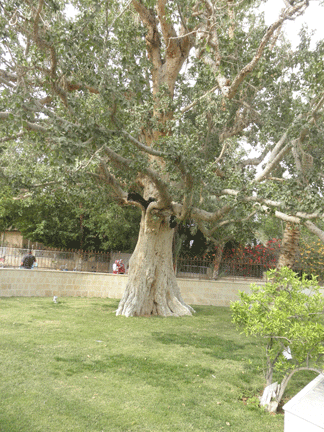
Zacchaeus's Sycamore Tree |
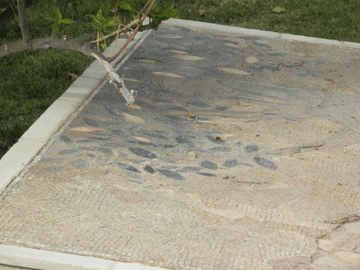
Ancient tile near the tree |
|
| TOP | ||
| Jericho. Saturday, March 31, 2012
Nabi Musa. The burial place of Moses The Bible describes the last days of Moses: "And Moses went up from the plains of Moab unto the mountain of Nebo, to the top of Pisgah, that is over against Jericho. And the LORD showed him all the land of Gilead, unto Dan, And all Naphtali, and the land of Ephraim, and Manasseh, and all the land of Judah, unto the utmost sea, And the south, and the plain of the valley of Jericho, the city of palm trees, unto Zoar. And the LORD said unto him, This is the land which I sware unto Abraham, unto Isaac, and unto Jacob, saying, I will give it unto thy seed: I have caused thee to see it with thine eyes, but thou shalt not go over thither. So Moses the servant of the LORD died there in the land of Moab, according to the word of the LORD. And he buried him in a valley in the land of Moab, over against Bethpeor: but no man knoweth of his sepulchre unto this day." Deutonoromy 34: 1-6 An ancient Holy Muslim site located on the side of the road from Jerusalem to Jericho is dedicated to Prophet Moses (Nebi Musa), who according to Muslim tradition is buried here near the red hill. This large walled complex includes 120 rooms, a large number of white capes above its roofs, and a high tower. A large cemetery is located in the fields around the complex. The annual of Nebi Musa festival attracted thousands of believers every year since it was constructed in 1270 by the Mamluke Sultan Baybars. | ||
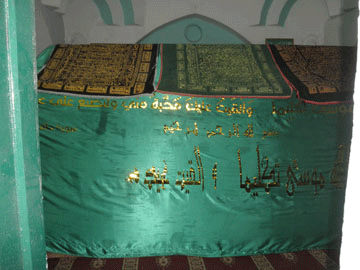
A Green cloth marks the place of the tomb of Moses. |
||
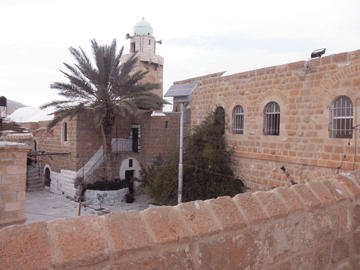 |
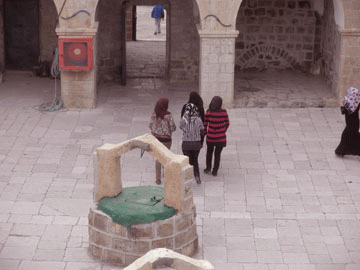 |
|
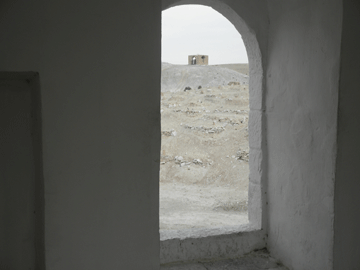 |
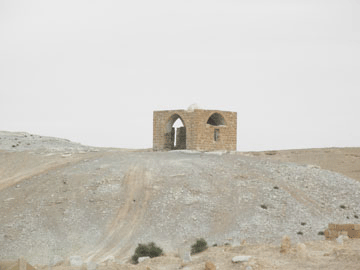 |
|
| The Tomb of Moses | ||
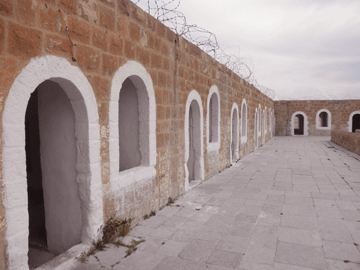 |
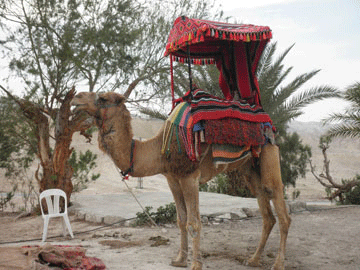 |
|
| Jericho. Saturday, March 31, 2012
St. George's Monastery St. George Orthodox Monastery, or Monastery of St. George of Koziba, is in in Wadi Qelt, in the eastern West Bank. The sixth-century cliff-hanging complex, with its ancient chapel and gardens, is active and inhabited by Greek Orthodox monks. It is reached by a pedestrian bridge across the Wadi Qelt, which many imagine to be Psalm 23's Valley of the Shadow. The valley parallels the old Roman road to Jericho, the backdrop for the parable of the Good Samaritan (Luke 10:29-37). The monastery is open to pilgrims and visitors. After our full day, we did not take the two-hour walk to the Monastery's entrance. | ||
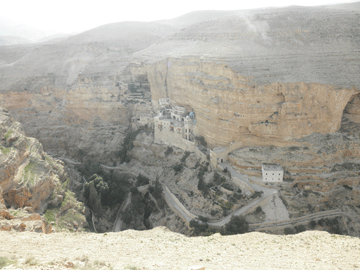 |
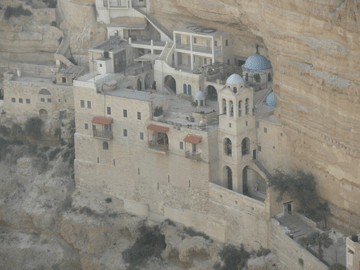 |
|
| A beautiful solitary place | ||
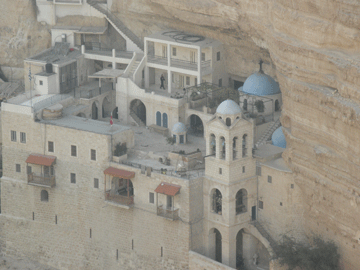 |
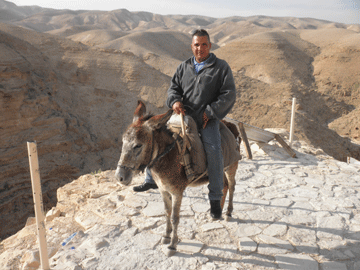 |
|
| Thanks to our guide for taking us here | ||
| TOP | ||
| Jerusalem. Sunday, April 1, 2012
Palm Sunday Procession and Pontifical Mass. Catholic Chapel of the Church of the Holy Sephulcher. Charlie came with me to Mass on Palm Sunday. It was for me, one more time on this trip, an experience of a lifetime. It began at 8 a.m. with the palm procession, followed by High Mass. The Mass was said in Latin but we were given booklets with the Latin translated in seven languages. The Booklet's Introduction in English is as follows: "In Jerusalem this re-enactment of the events of PalmSunday is celebrated in the morning with the blessing and distribution of palms. The assembled faithful process aroung the aedicola (the marble surrounding of the Lord's tomb, in the church of the holy Sepulcher) and then wend their way up to 'Calvary. In this way this celebration links clearly and visably the unity which exists between Christ's death and His glorious resurrection. All present carry palms to signify Christ's royal triumph over sin and death, even whilst hanging from the cross. This morning's celebration culminates with High Mass offered in front of the aedicula, the very place where Christ was laid in the tomb and rose gloriously to heaven. Before the procession and celebration begins, palms are placed in the chapel of the Angel, where they will be blessed by the bishop. When all is ready, the palm procession betins from the chapel of the Apparition to the aedicola of the resurrection. During this time, as on that day, the crowd shouted to the Lord, so now today the choir and people re-echo those words with the following antiphon: 'Hosanna to the Son of David, the King of Israel. Bless is He who comes in the name of the Lord. Hosanna in the highest.'" (from Dominica in Palmis de Passione Domini) | ||
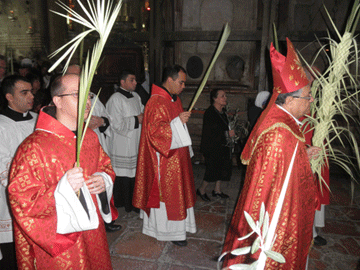 |
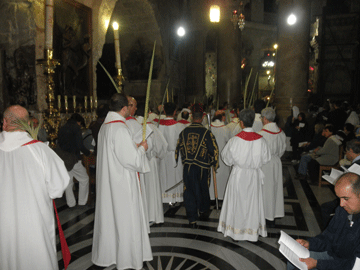 |
|
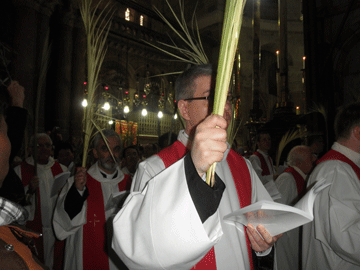 |
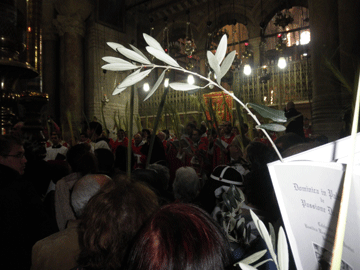 |
|
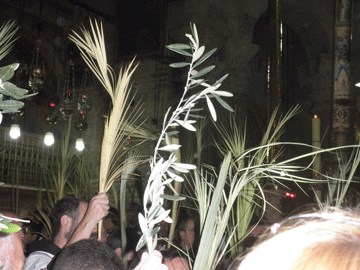 |
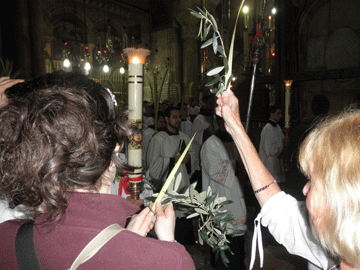 |
|
| TOP | ||
| To Ramallah. Sunday, April 1, 2012 | ||
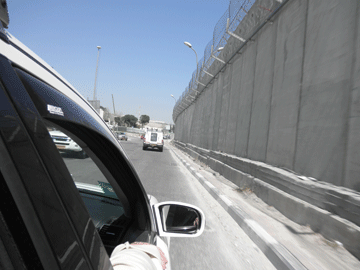
Checkpoint |
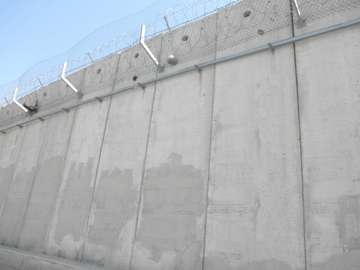
The Wall |
|
| Ramallah. Sunday Afternoon, April 1, 2012
Yasser Arafat's Tomb | ||
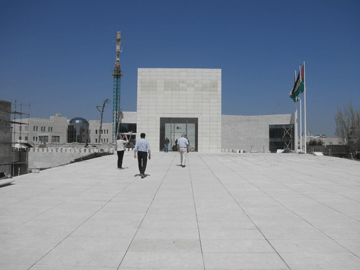 |
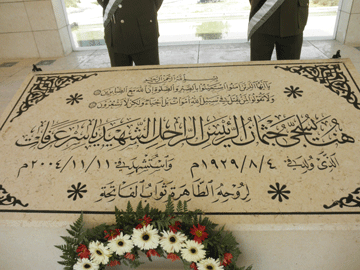 |
|
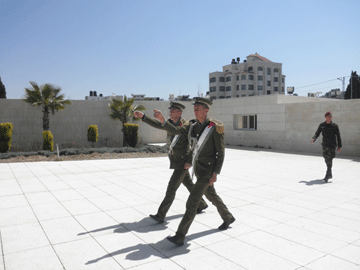 |
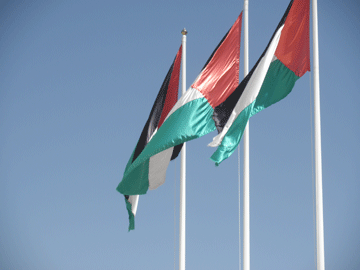 |
|
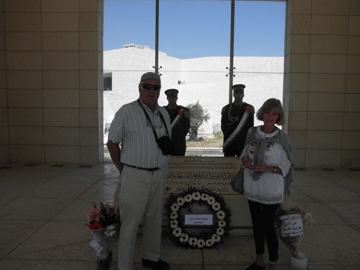 |
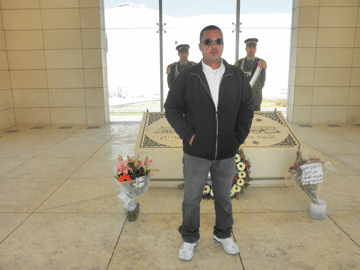 |
|
| TOP | ||
| Ramallah. Sunday Afternoon, April 1, 2012
In the City of Ramallah Our guide let us loose in the city, telling us to stay together and meet him back at the car in an hour. The City was bustling, shops open, people shopping. (Sunday is a work day for Palestinians.) Charlie discovered a bakery filled with right-from-the-oven pastries. We bought a few to enjoy with coffee. The bakery had a cafe upstairs, but I thought I had spied a Starbucks down the road and convinced everybody to go there, so we took our sweets to Starbucks. A big mistake. It wasn't Starbucks. It was Star and Bucks, nothing like Starbucks, no baristas, no WiFi. However, I had a mission to accomplish. I had decided to buy two T-shirts for my grandson, one Israeli and one Palestinian, and since Ramallah, not Tel Aviv, was, to Palestinians, the capital of Israel, I was sure I could find a Palestinian T-shirt here. I went up and down the main street, from shop to shop, explaining what I wanted. Every shop had Disney T-shirts in English and sports T-shirts with English logos. This is crazy, I thought. Every place you visit in America has a T-shirt celebrating itself. Why not here? I gave up and planned to look in East Jerusalem when I got back. It took a little time to figure out how to cross the main square. There were barriers and you had to find the opening where you could cross. I had lost sight of my friends and was trying to figure out which way to go, when a very nice man offered to help. He led me to the opening and stayed with me till we caught up with Charlie, Bill, and Cynthia. Palestinians are very friendly. Women make eye contact and smile as they pass you on the street. And men are ready to help you. |
||
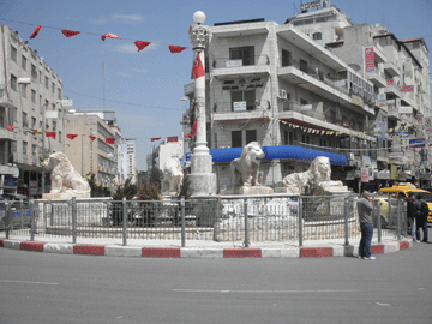
| ||
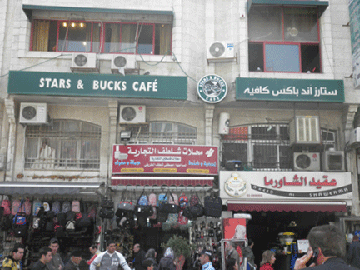 |
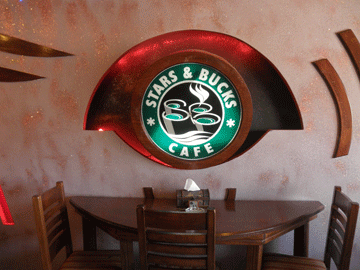 |
|
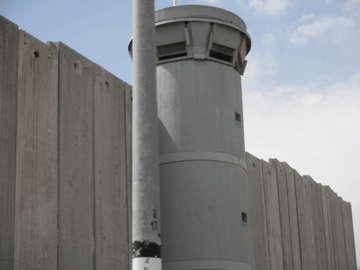 |
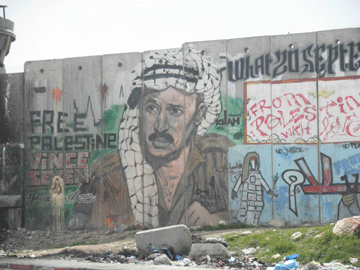 |
|
| TOP | ||
| Jerusalem. Sunday Afternoon, April 1, 2012
Palm Sunday Procession "In the afternoon, the Church of Jerusalem follows the path our Lord and Savior took from Bethfage unto the Holy City. The Church re-enacts as closely as possible the crowd and events that came to pass on that day." (from Dominica in Palmis de Passione Domini) | ||
| Walking in the Palm Sunday Procession was very exciting for Cynthia and me. Our guide dropped us off at the top of the
Mount of Olives. We bought palm branches from children and began following people down a hill to Bethfage Church, where a crowd had gathered.
There we chatted with an American girl from Gordon College, heard conversations in multiple languages, and waited for the procession to begin.
Everybody was in a festive mood.
About a half hour later, we began slowly making our way to the top of Mount of Olives. Leading the procession was a man with a guitar, and every time the procession paused to rest, he would play and everyone would sing or dance along, and everyone would shake their palms up and down to the beat. People were lined up on sidewalks and outside buildings cheering us on. Television camers from around the world were hanging over the road. Spontaneously, a group would start singing and everyone would join in. The most popular songs were repeated several times. One was "Jerusalem" and the other "Hosanna," and by the time we got near the bottom, we almost could sing the lyrics, though we couldn't translate them. At one point, a group of American catholic school girls in their uniforms began reciting the rosary and I said it along with them. The procession ended in the Old City at St. Anne's Catholic Church, where a musical group was performing. It was an awesome experience at the end of an awesome day. Cynthia and I had freshly-squeezed orange juice at a stand in the Old City, and the man brought out two chairs for us to rest our tired feet while we drank our orange juice. | ||
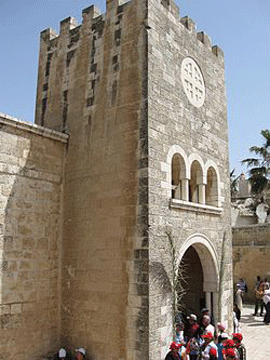 |
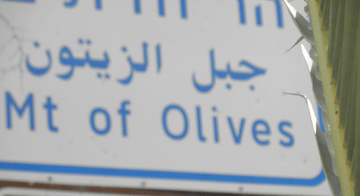 |
|
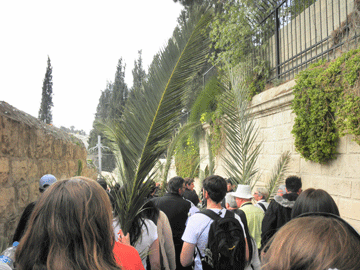 |
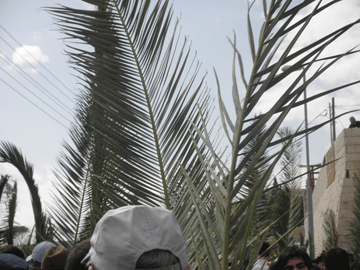 |
|
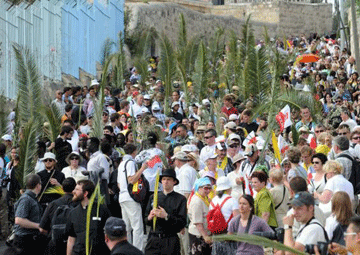 |
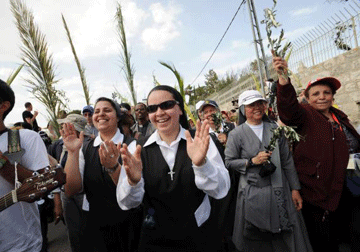 |
|
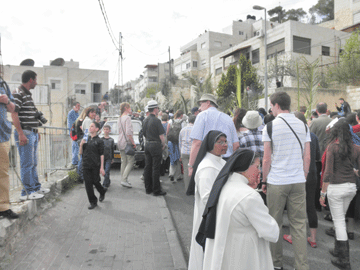 |
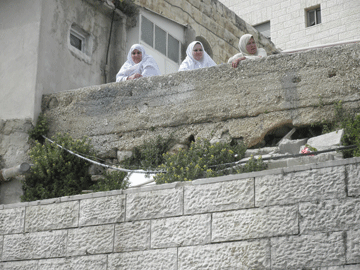 |
|
| TOP | ||
| Jerusalem. Monday, April 2, 2012
Our last day. I had two goals for the morning. First, to get our granddaughters crosses blessed. Second, to find a T-Shirt with something Palestinian on it. Charlie came with me. First, we went to Notre Dame. Charlie waited outside while I went in to find the priest. I told the woman at the desk what I wanted. She called the priest. He would be here in 15 minutes, she told me, so I sat in the lobby and waited. He came, blessed our crosses and blessed me. Next, we went back to our Palestinian neighborhood to find a T-Shirt. I went from shop to shop, saw the same American T-Shirts that I saw in Ramallah and got the same responses from the shopkeepers. I was about to give up, when we passed a rather upscale men's clothing shop. I went in and told the man what I wanted. He paused, looked me in the eye and said, "We don't have what you want. You won't find what you want. What you want does not exist." | ||
| Jerusalem. Monday, April 2, 2012
Yad Vashem Museum. The Holocaust Museum. "The Holocaust History Museum occupies over 4,200 square meters, mainly underground. Both multidisciplinary and interdisciplinary, it presents the story of the Shoah from a unique Jewish perspective, emphasizing the experiences of the individual victims through original artifacts, survivor testimonies and personal possessions." | ||
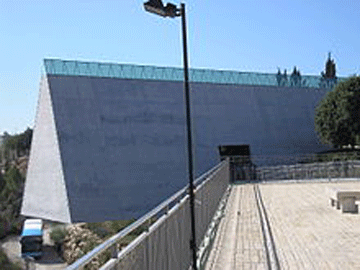 |
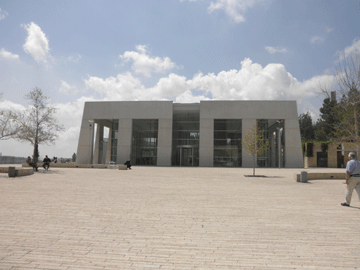 |
|
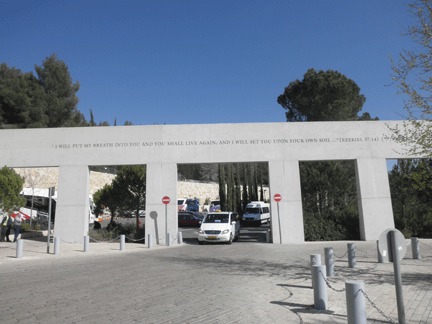
"I will put my breath into you and you shall live again, and I will set you upon your own soil. ..." (Ezekiel: 37-14) |
||
| TOP | ||
| Jerusalem. Monday, April 2, 2012
Mount Herzl. "Mount Herzl serves as the burial site for prominent Zionists, Israeli politicians and those figures who greatly influenced the development of the state (Theodor Herzl is interred there, his gravestone always covered in rocks, as are Yitzhak Rabin and Golda Meir), but the true spirit, and the true anguish, of Mount Herzl lie in the vast expanse of the Israel Defense Forces' official military cemetery." | ||
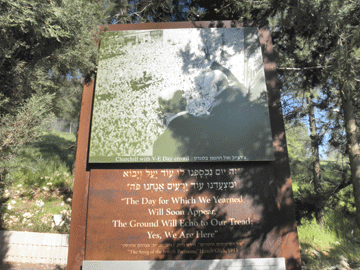 |
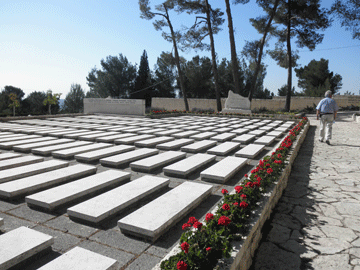 |
|
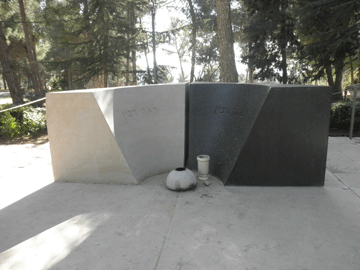 |
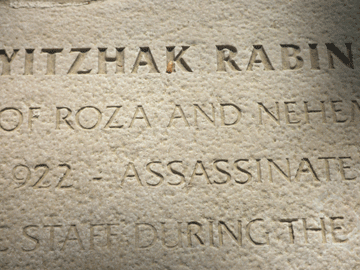 |
|
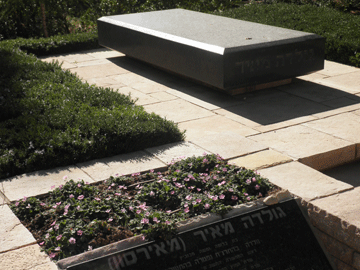 |
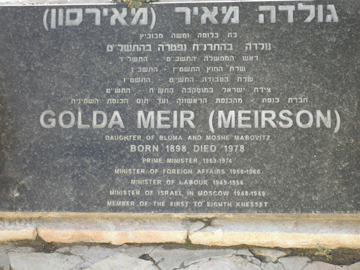 |
|
| The best part of our last day in Israel was walking in the
Mount Herzl cemetery. That might sound strange to anyone who had not just
come from the unbearably distressing walk through the holocaust museum.
After about 10 minutes in that dark endless underground tunnel, I removed
the headphones because a sign and a voice repeated the same information
at every stop. To view each display in the correct order, you have to keep
walking from the left side to the right side of the tunnel. We each walked
at a different pace, so we mostly went through this alone. Also, there were
very few other visitors. Endlessly, display after display, survivors are
telling their stories on a large screen, to the point where you become desensitized.
At that point I stopped looking and listening and just wanted to get out.
Then I found Charlie, and he was feeling the same way. We wove back and
forth till we finally could see sunlight, and I practically ran to the end.
We sat in the sun in a courtyard and waited for Cynthia and Bill. Then,
we walked slowly up the hill to Mount Herzl. Cynthia, Bill, Charlie, and I, along with the Israeli army bivouacking that week on Mt. Herzl were the only visitors. It's hard to explain how hundreds of soldiers and a graveyard could be uplifting, but I think the four of us felt that way. It was peaceful and beautiful. One group of soldiers was sitting in a circle while a young woman played the guitar. We saw soldiers heading in one direction so Charlie followed them, and we followed him, into a large stadium. We talked to a few and found out that they were practing for the Israeli Independence Day celebration on April 25th. We sat on the stands and watched them practice. Everywhere in Israel, I have been impressed by the young women and men in the military. They look at you and smile. You ask a question and they're happy to respond, in perfect English. They are young and fit and handsome, and you just pray that they will never have to use those machine guns. | ||
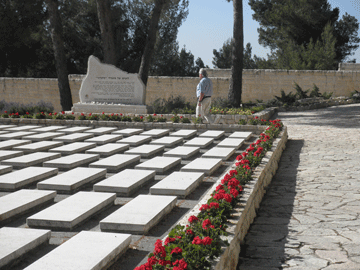 |
||
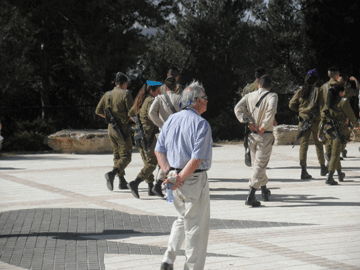 |
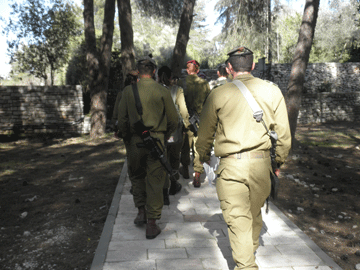 |
|
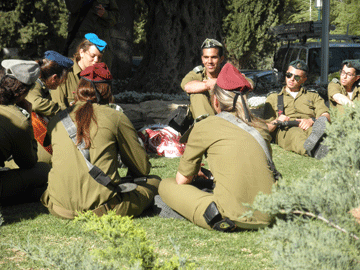 |
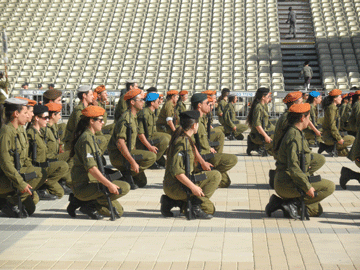 |
|
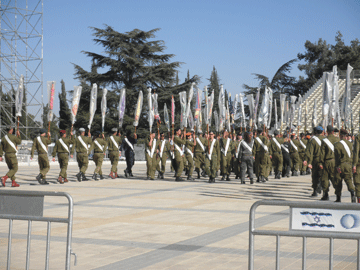 |
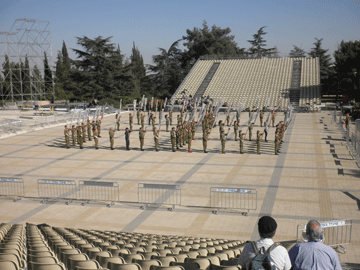 |
|
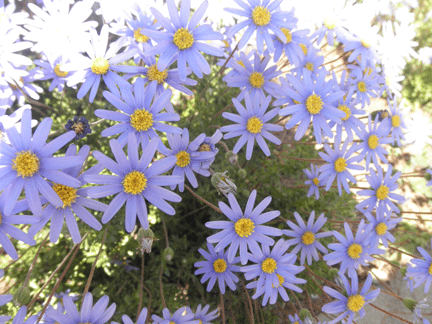 |
||
| We went back to our hotel, packed our suitcases, and waited in the Palatin Hotel's pleasant tea room with Cynthia and Bill until our taxi arrived to bring us to the airport for our 1:00 a.m. flight. Cynthia and Bill were leaving the next morning. We had celebrated our once-in-a-lifetime trip together the night before at dinner in Adom, another great Israeli restaurant. | ||
| TOP |